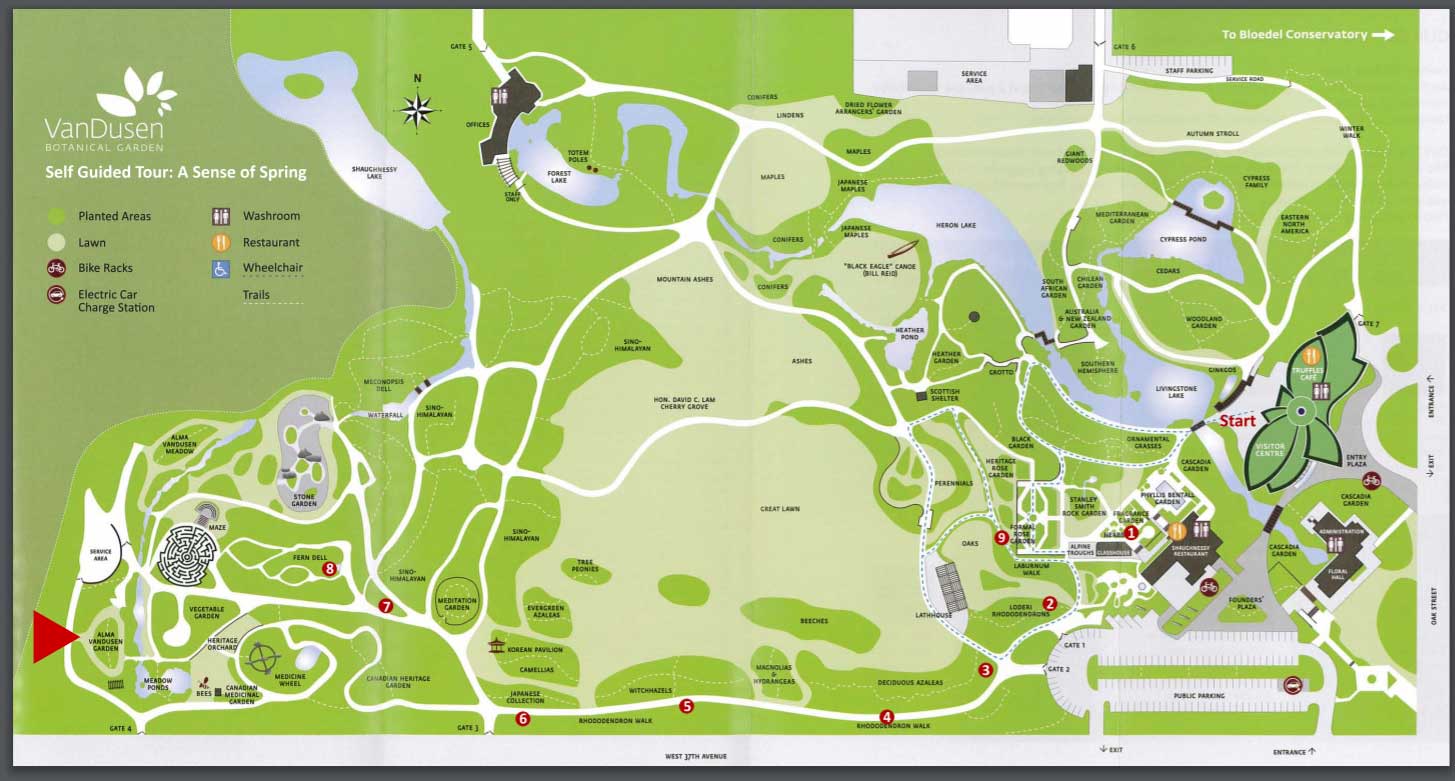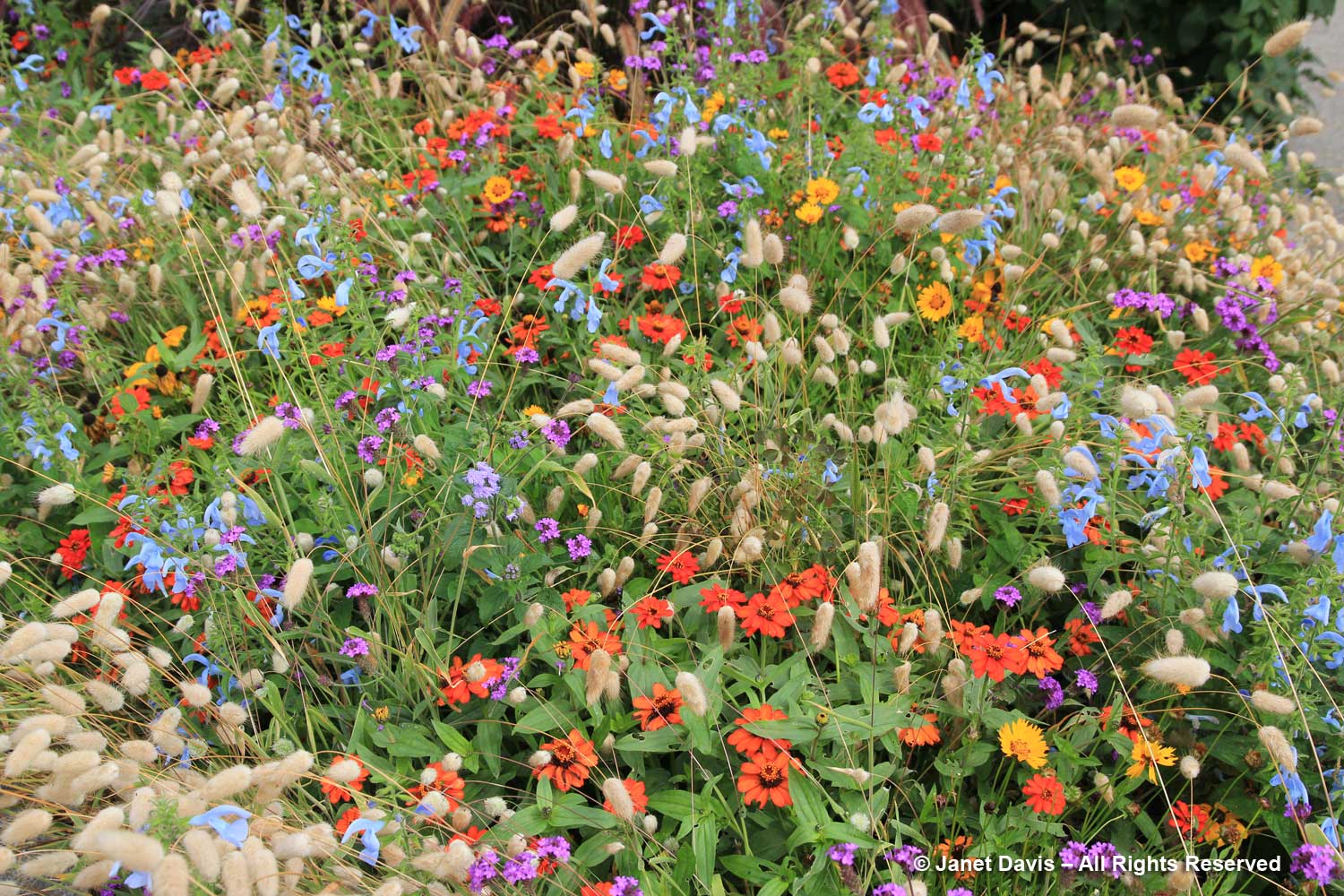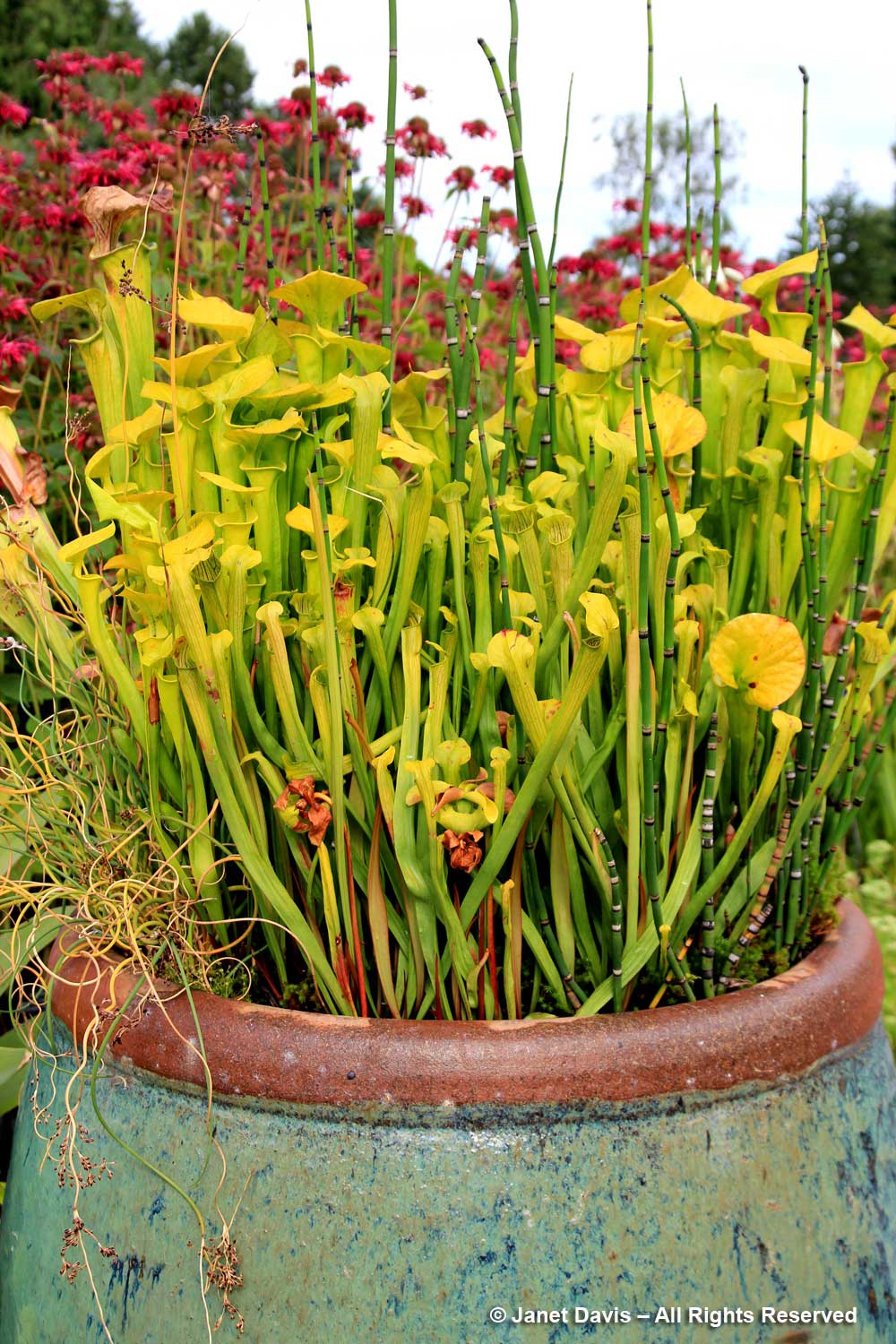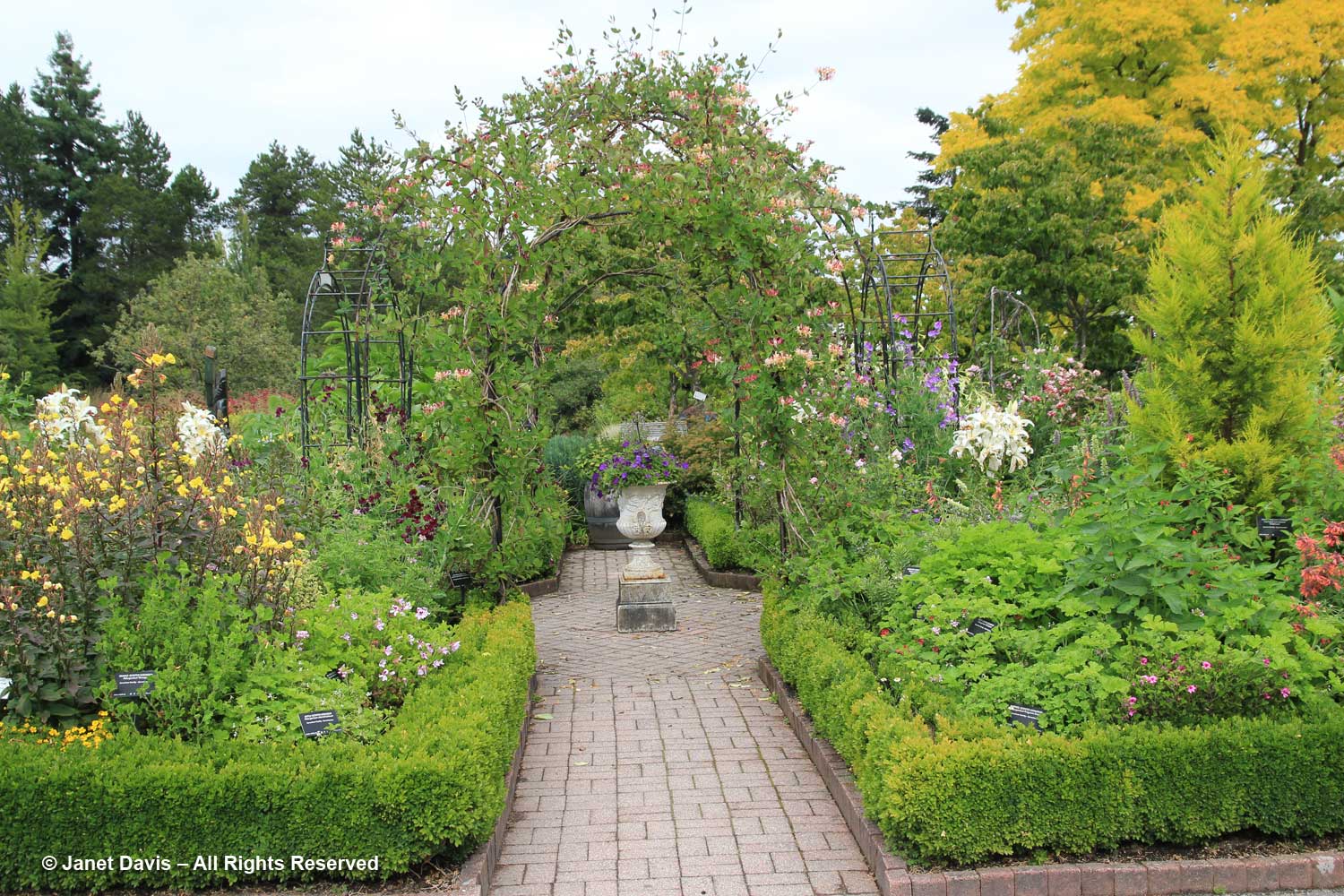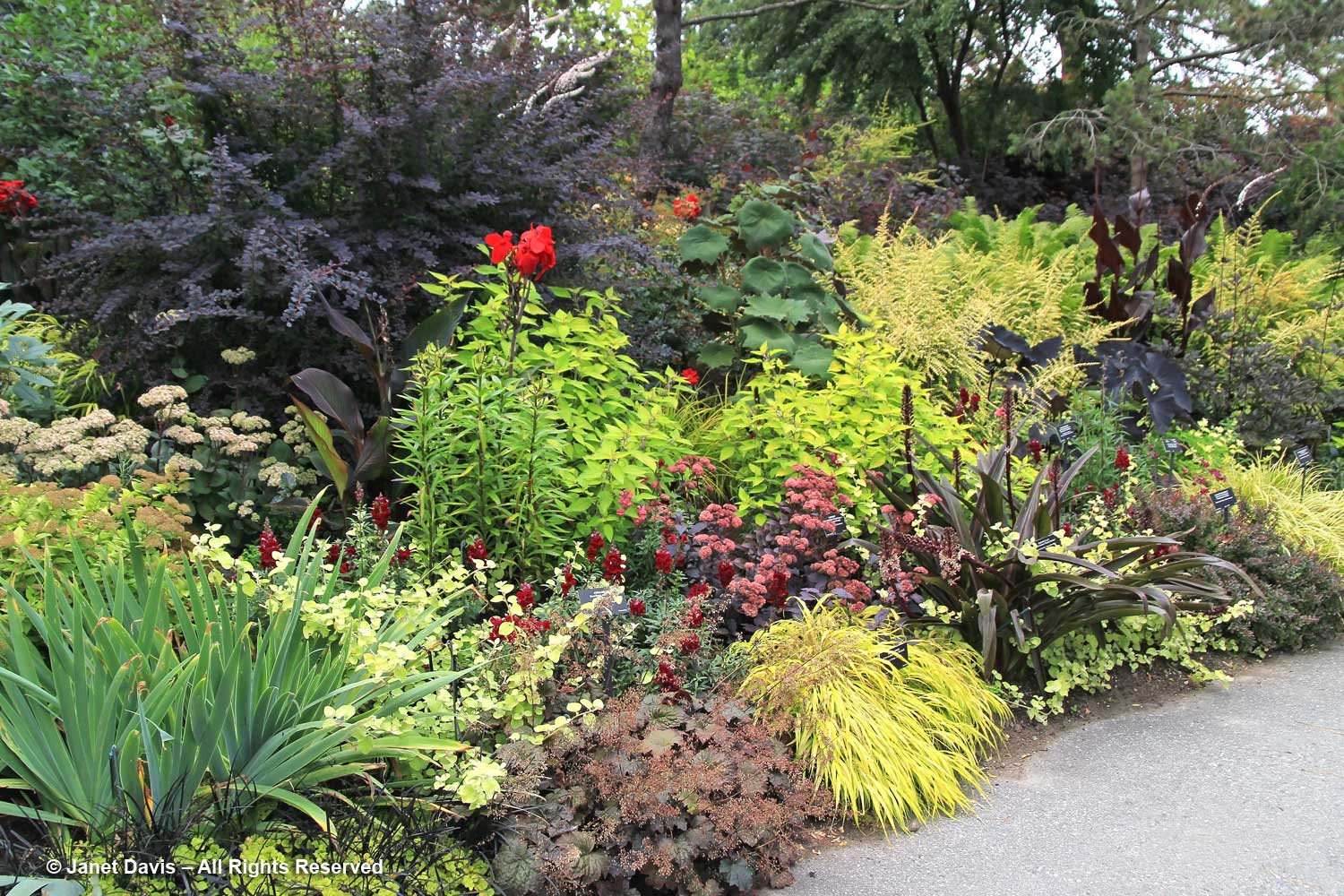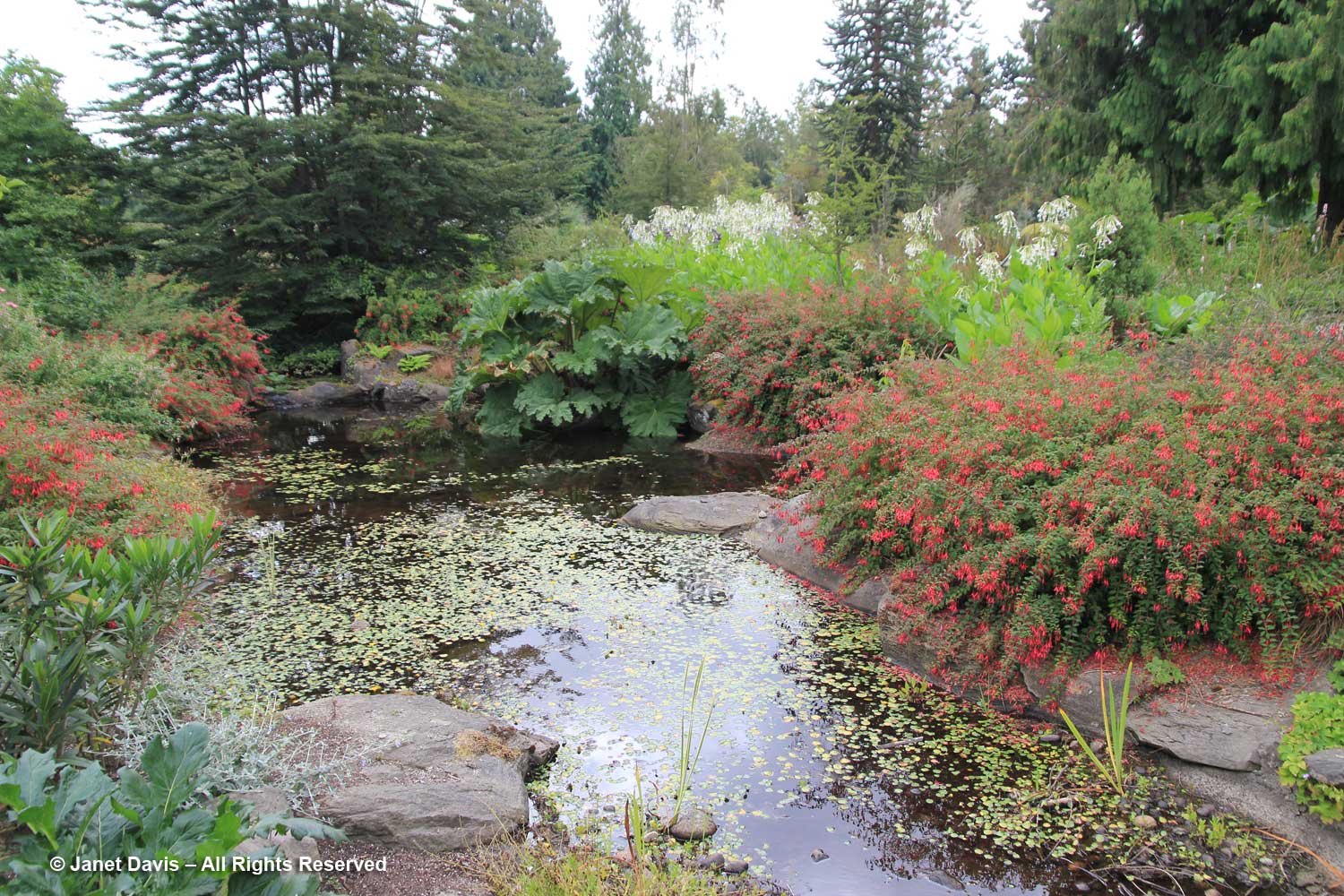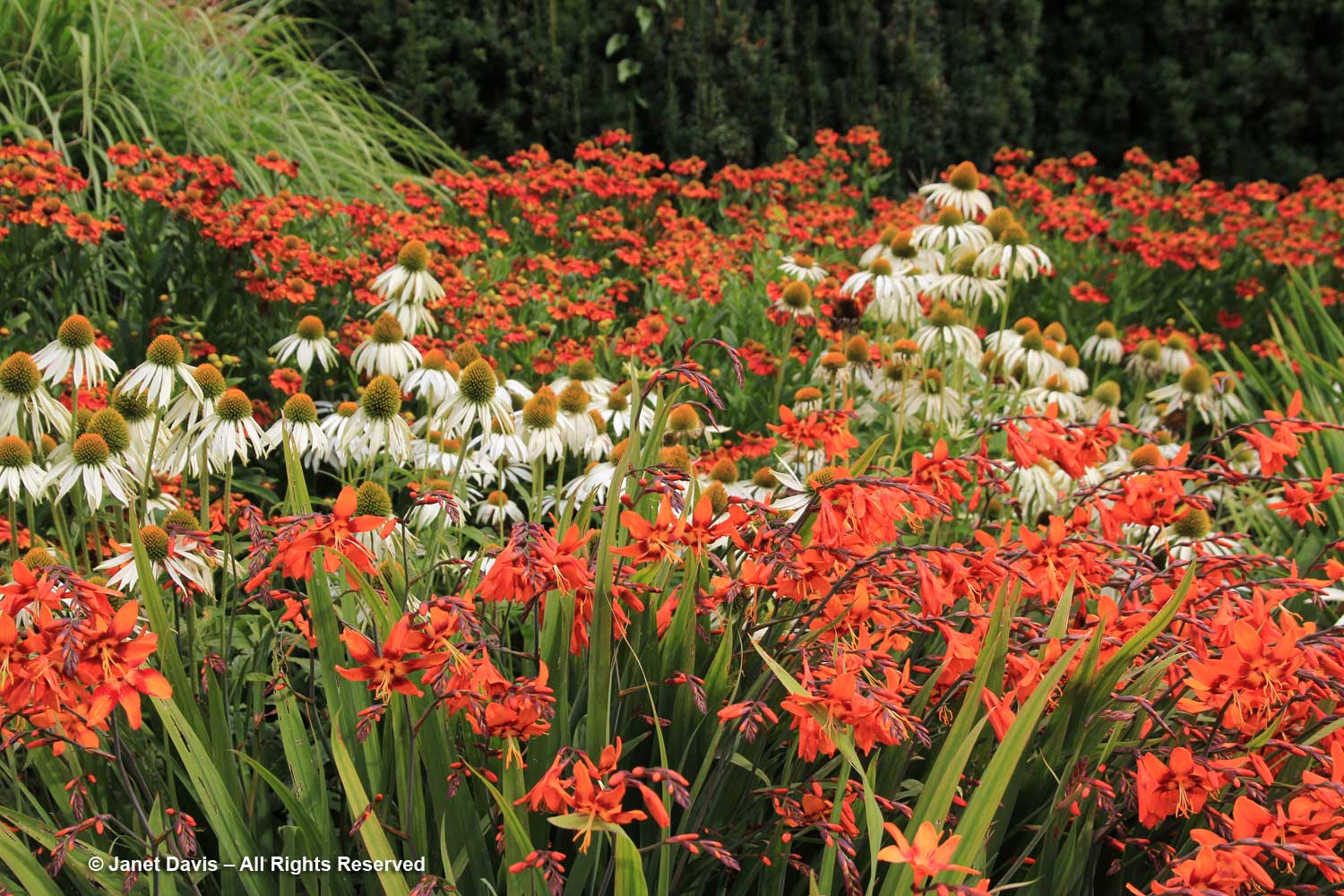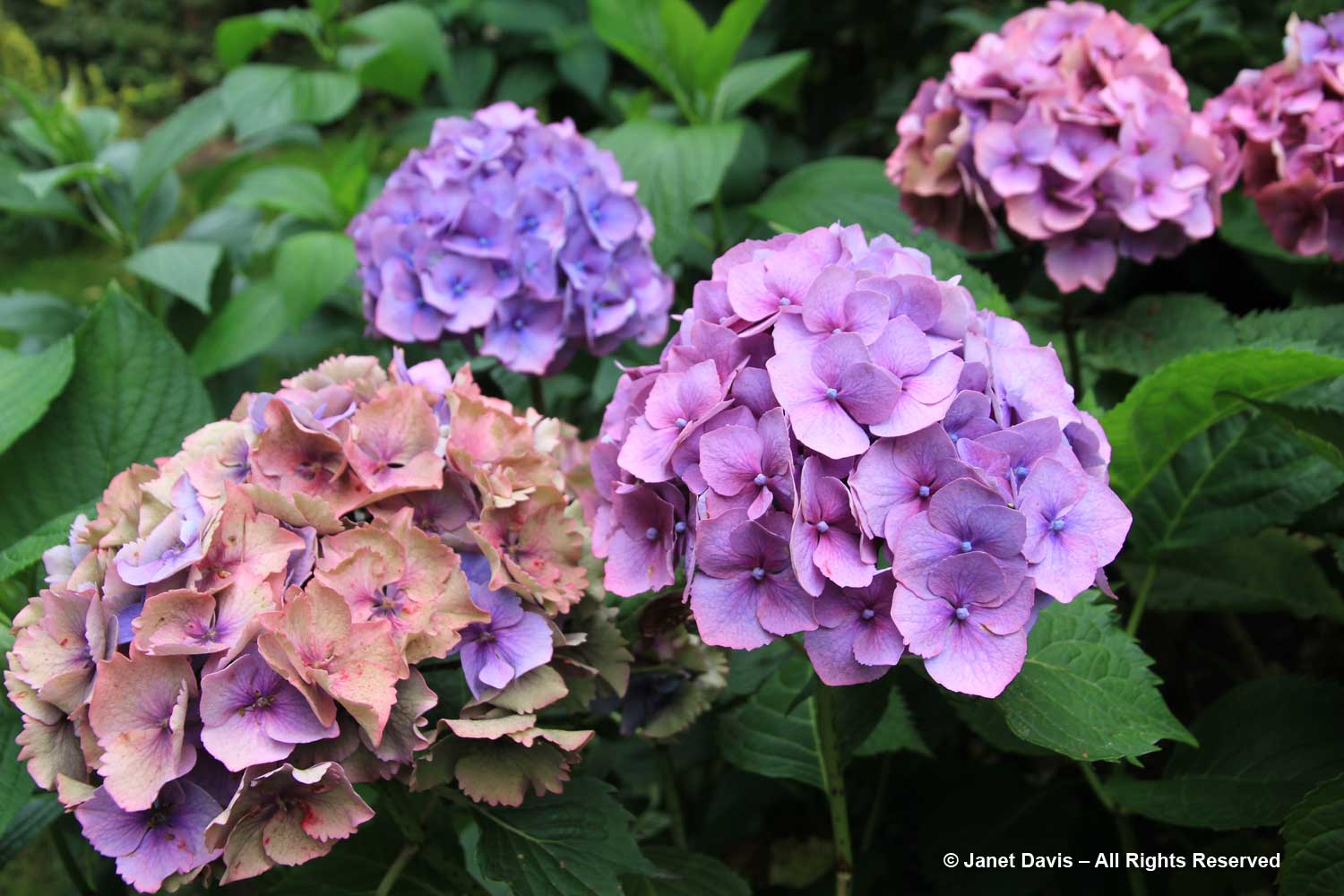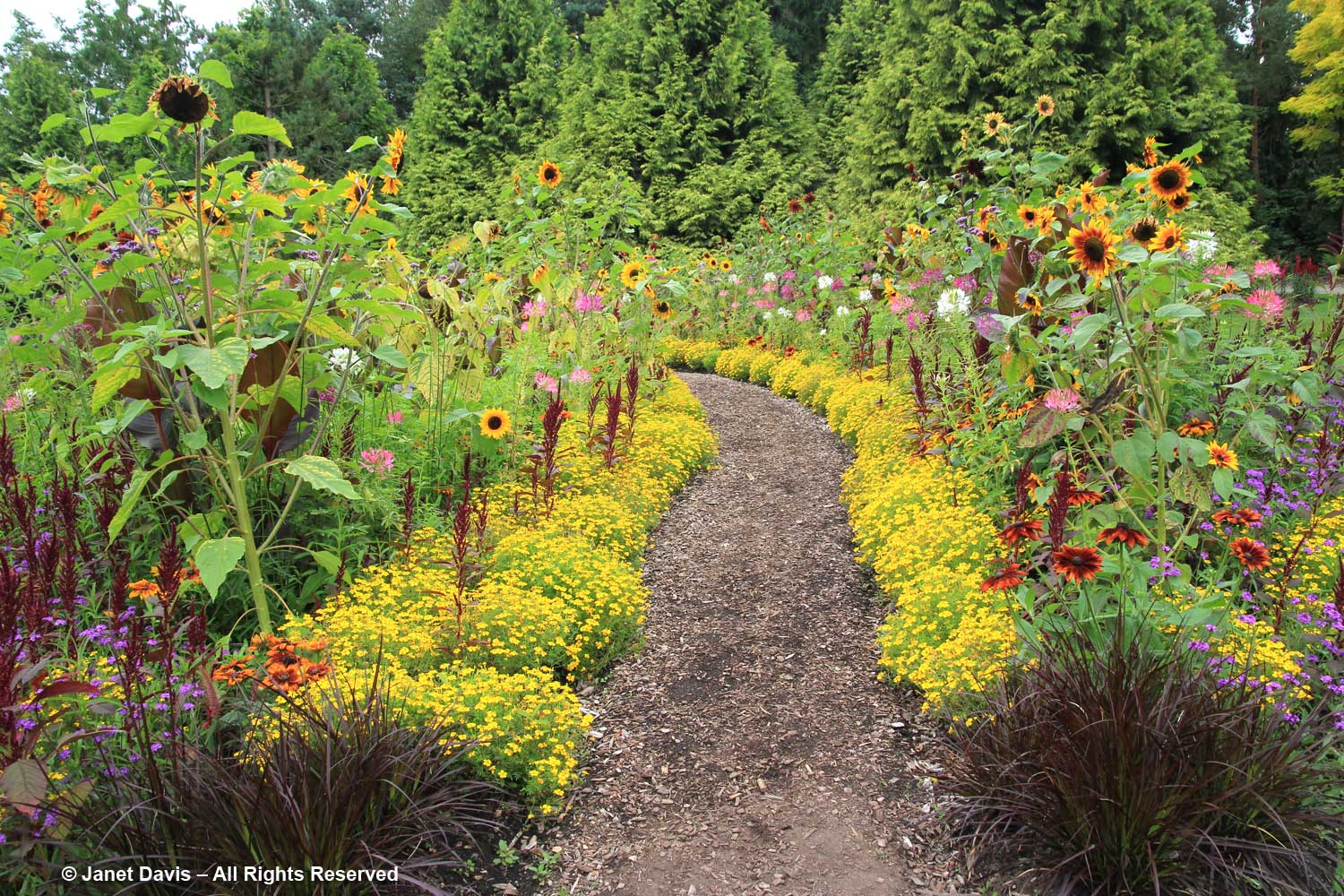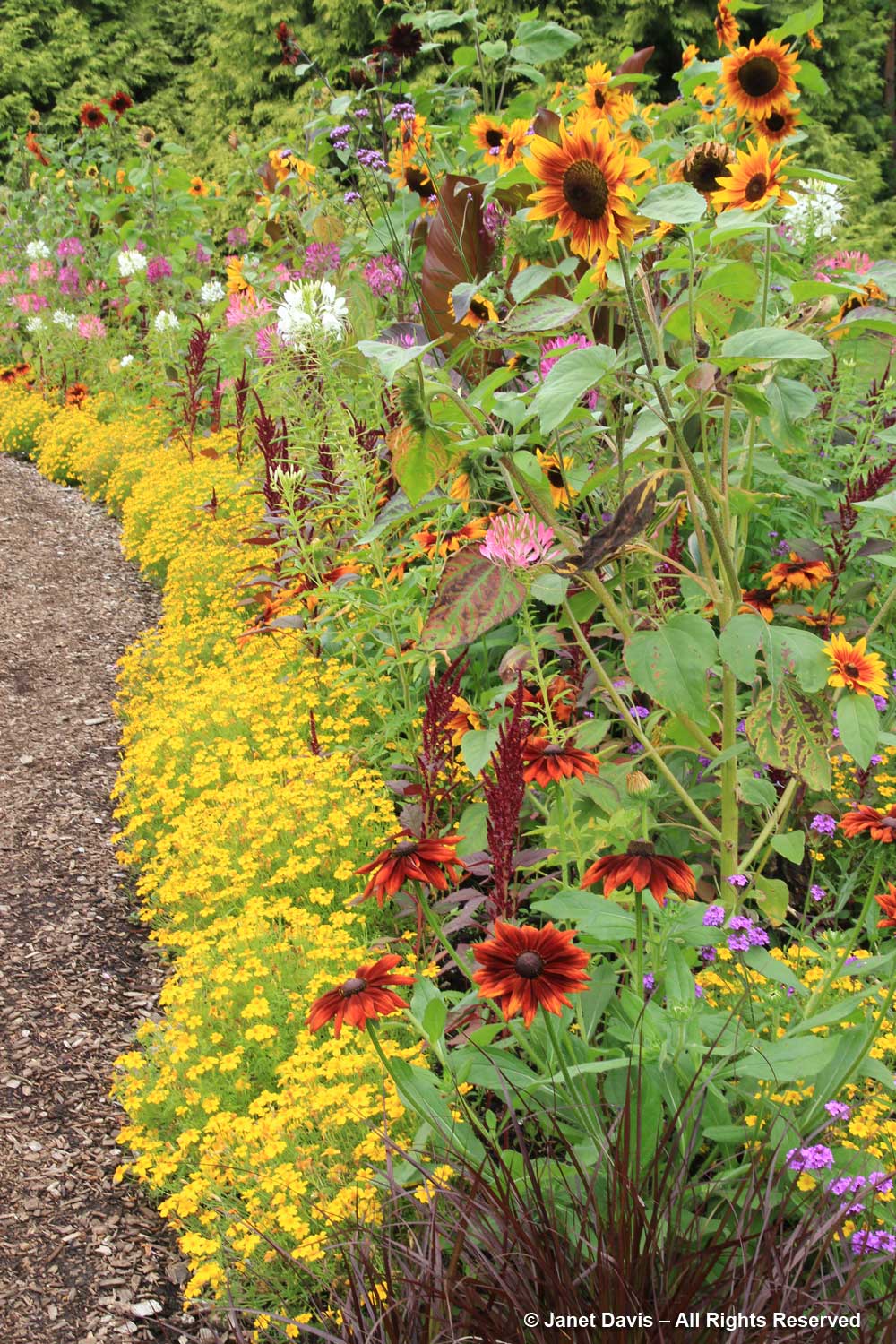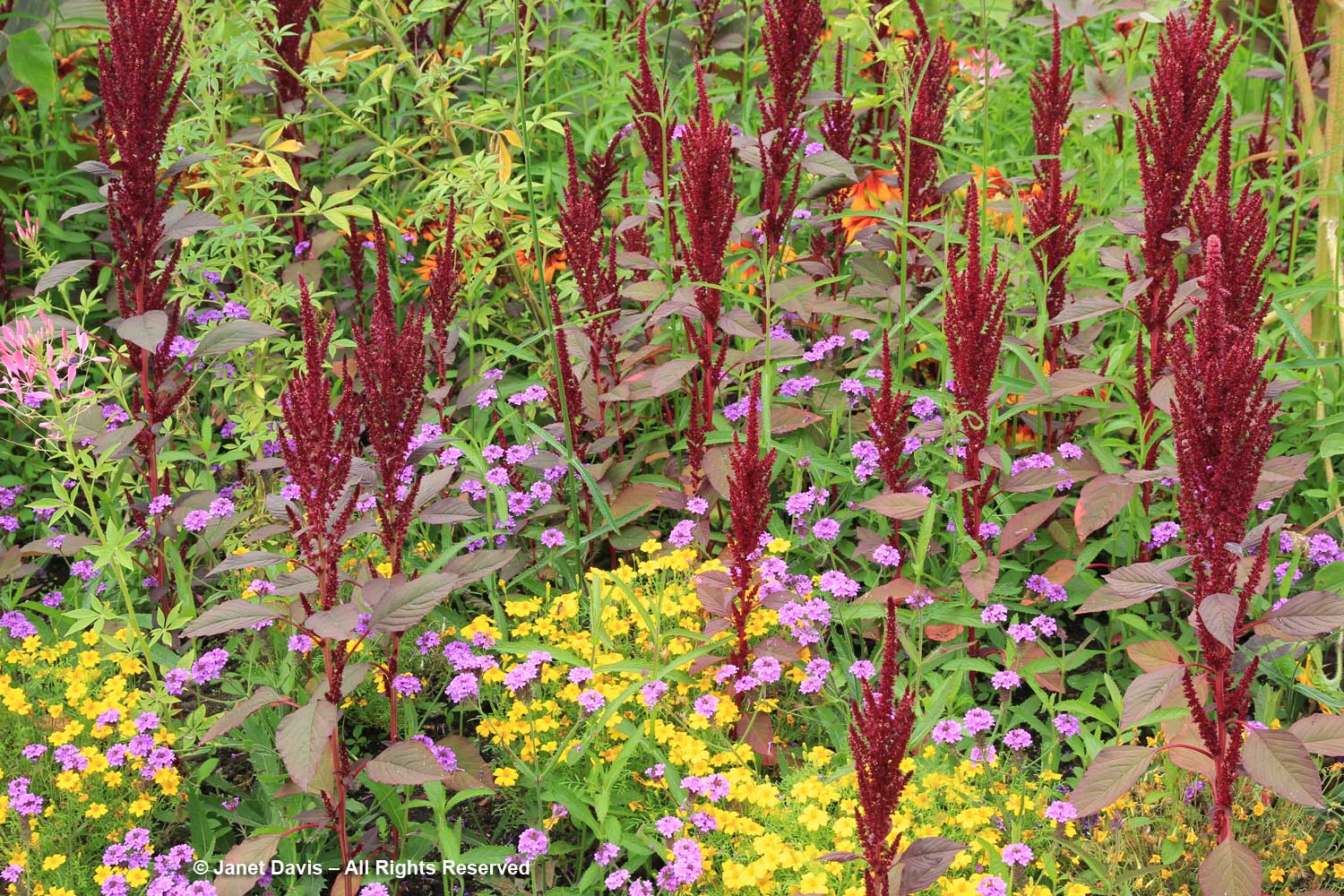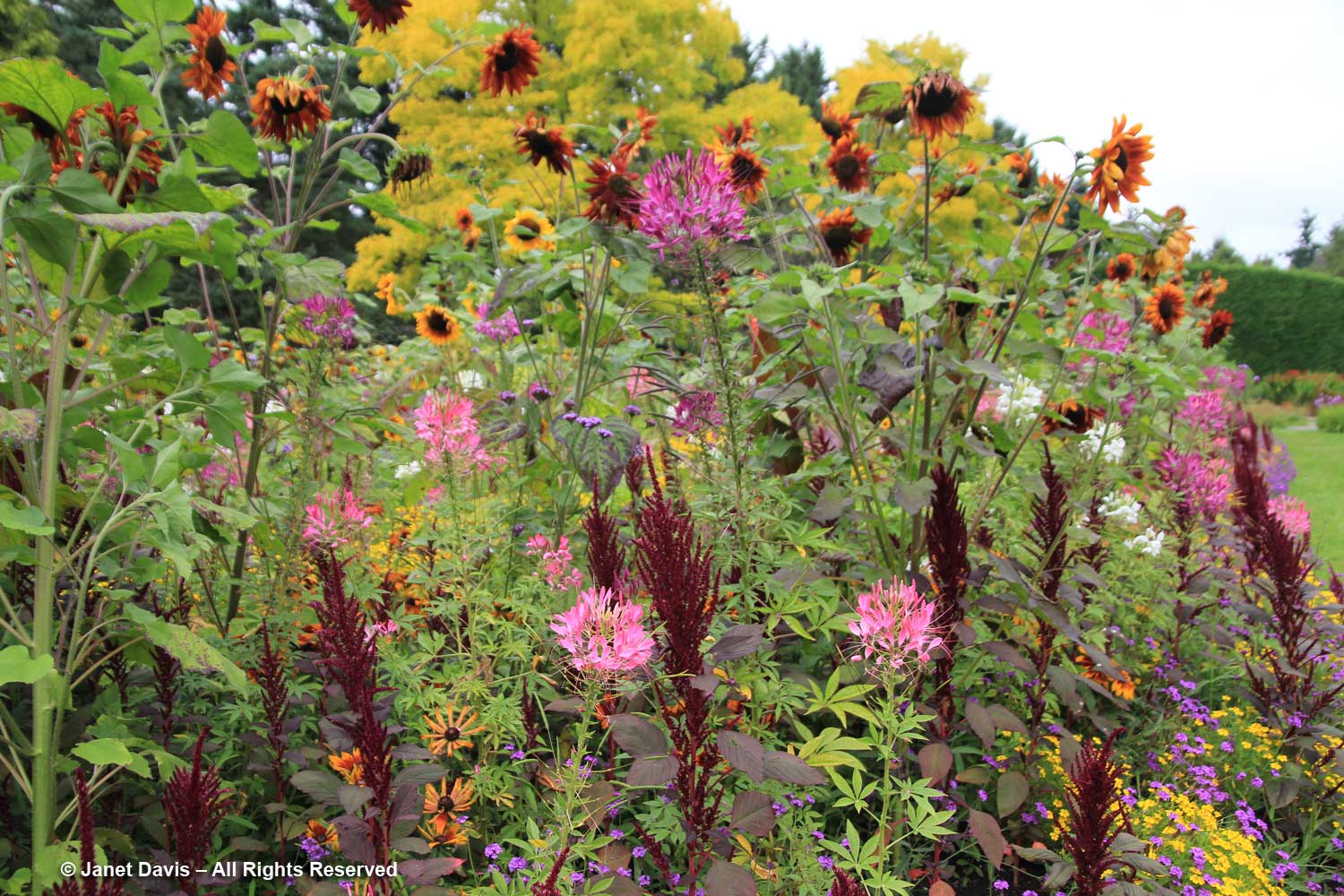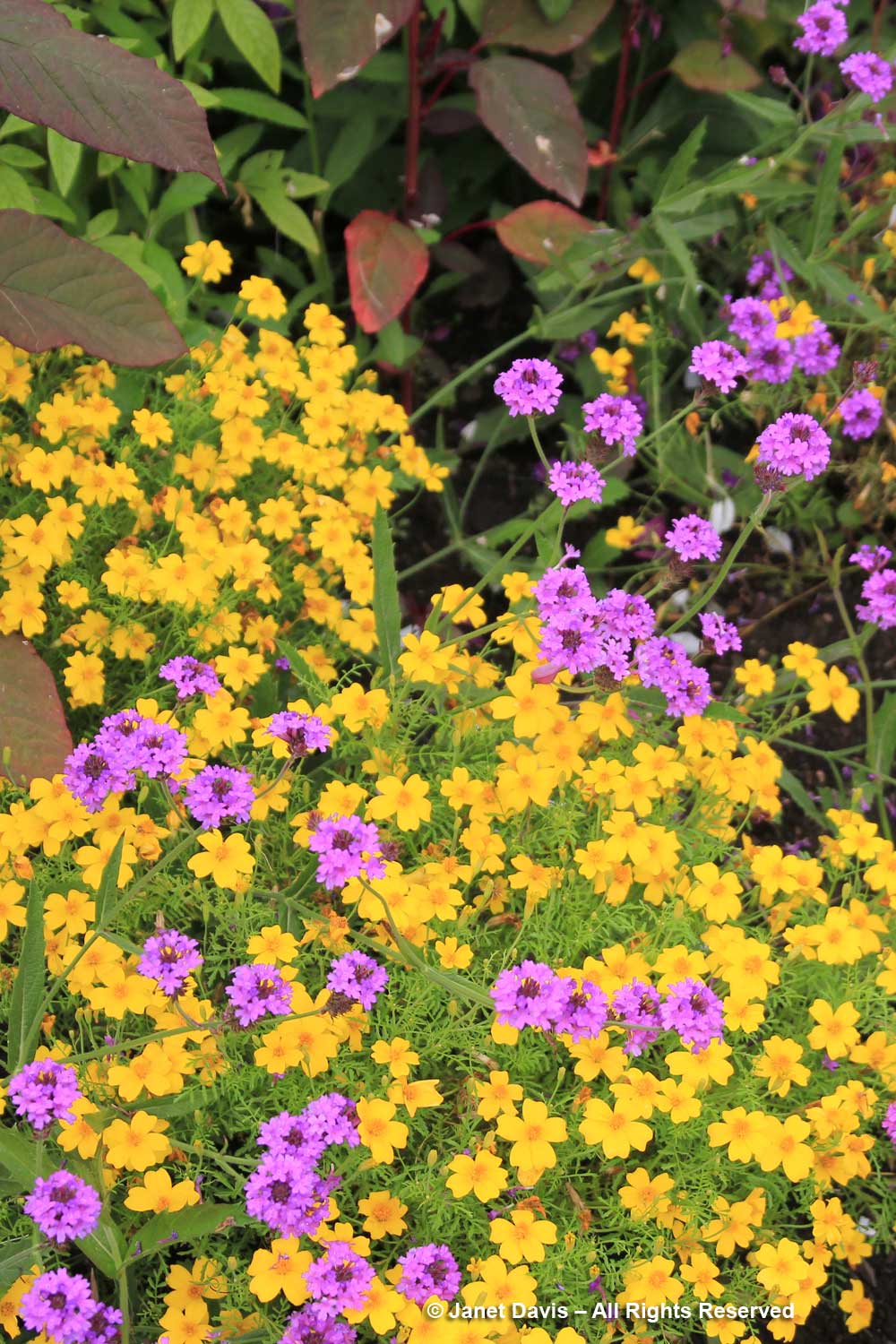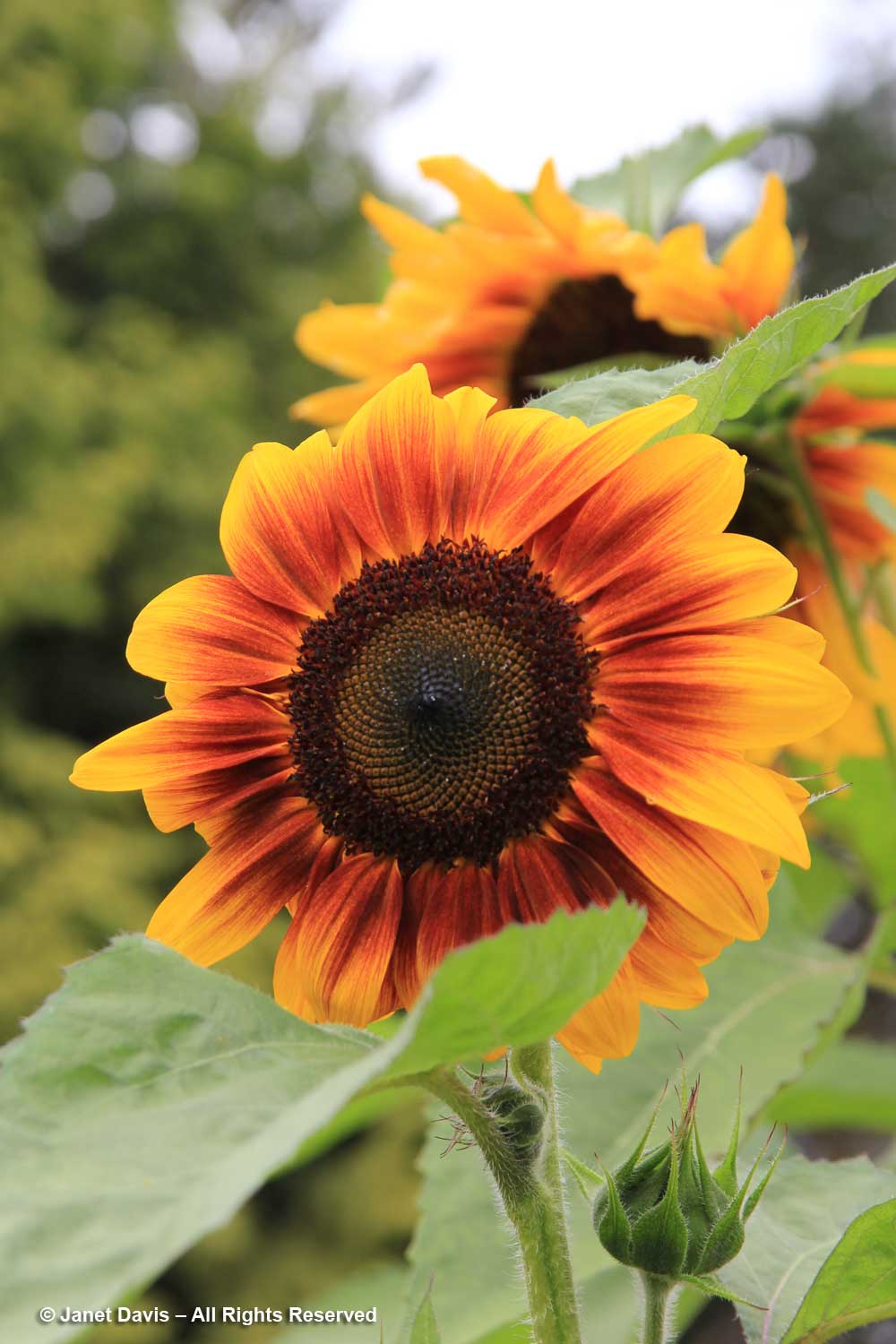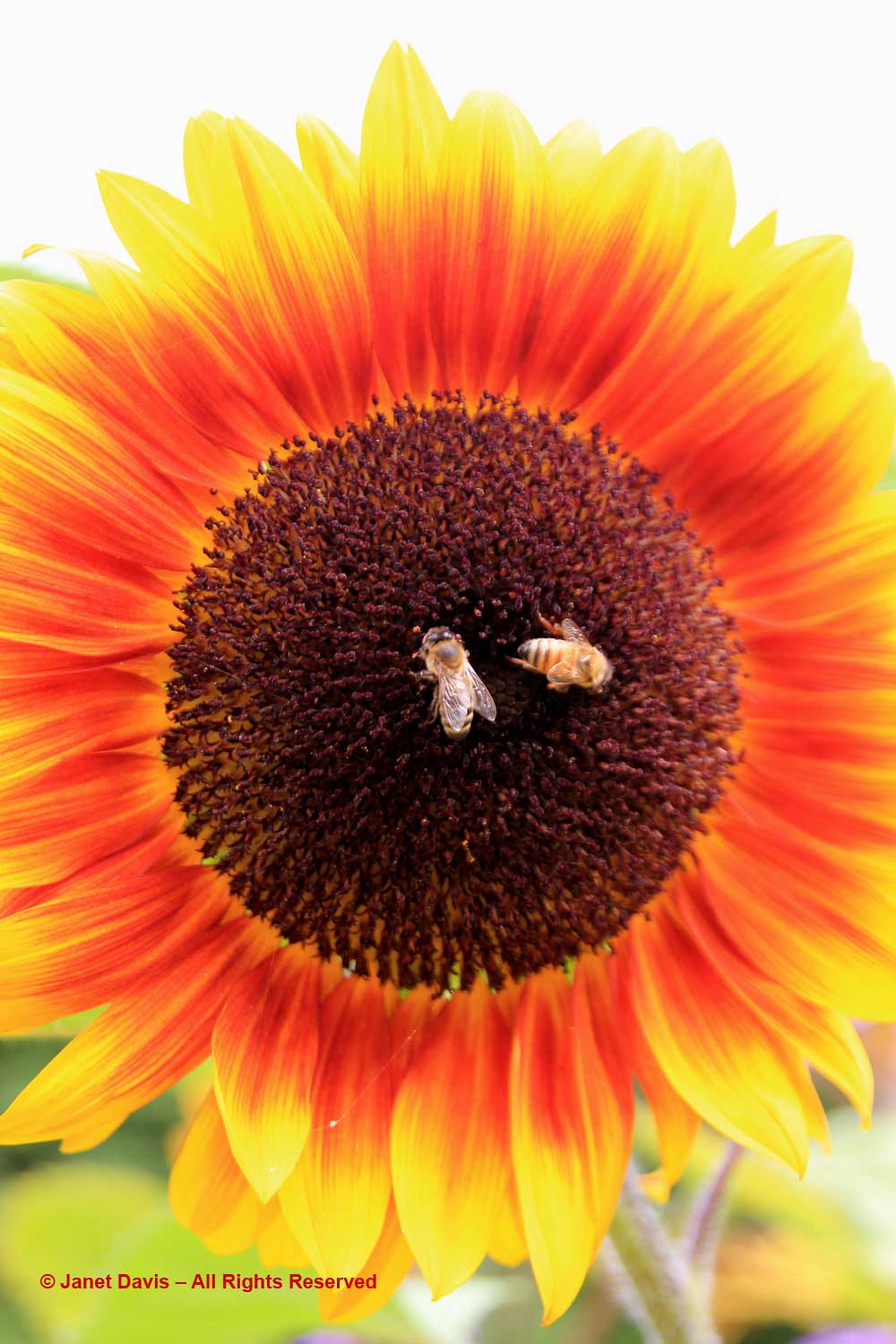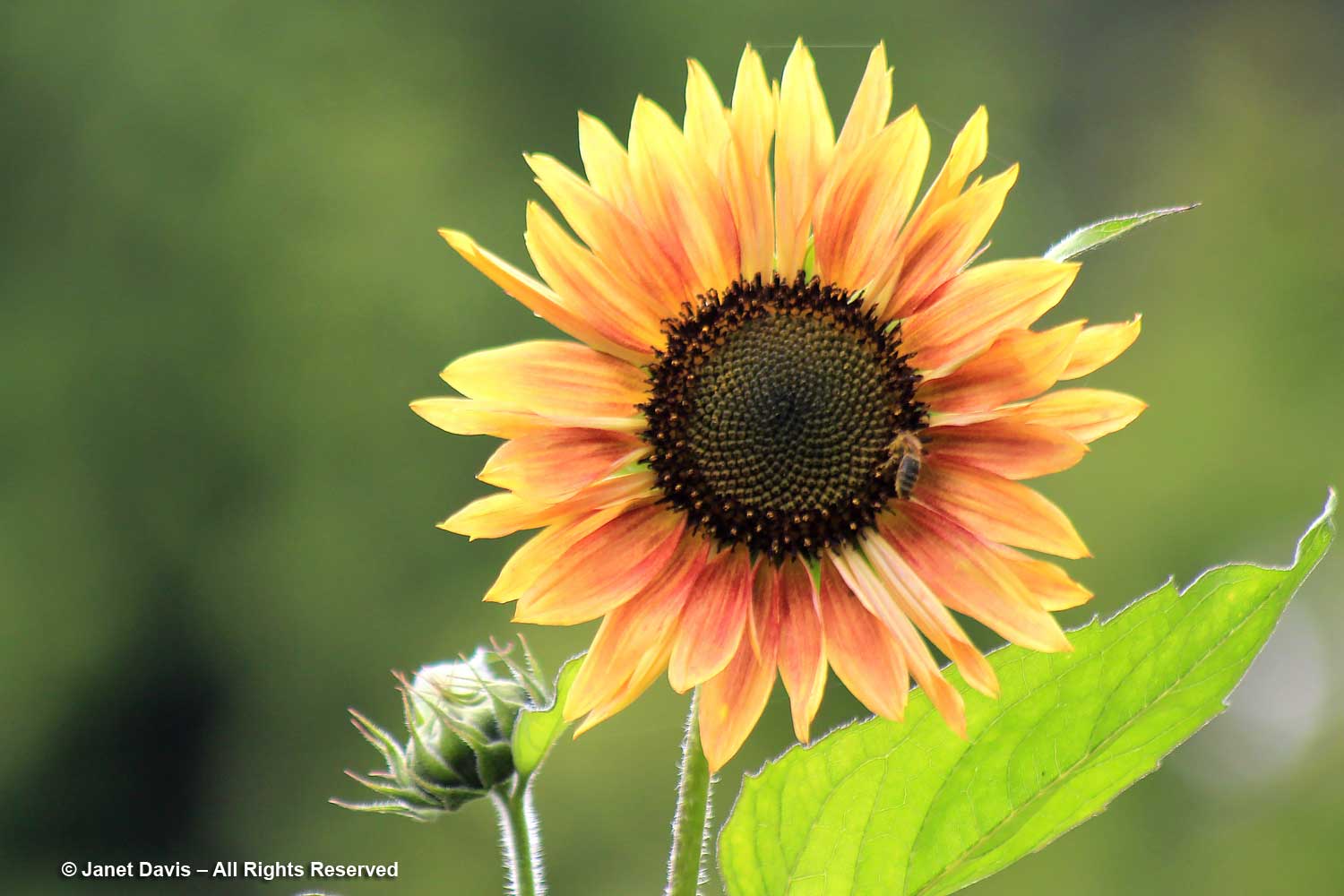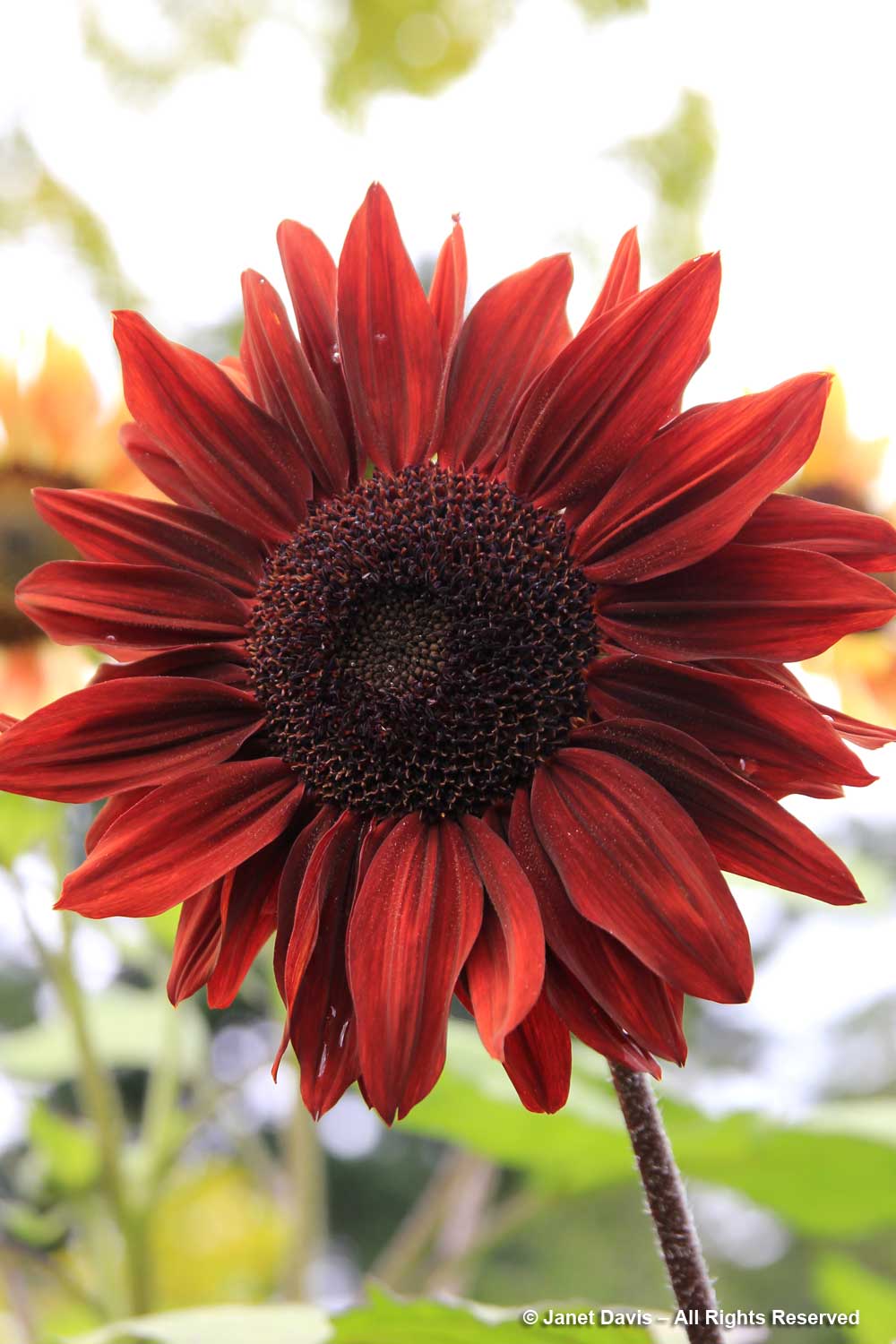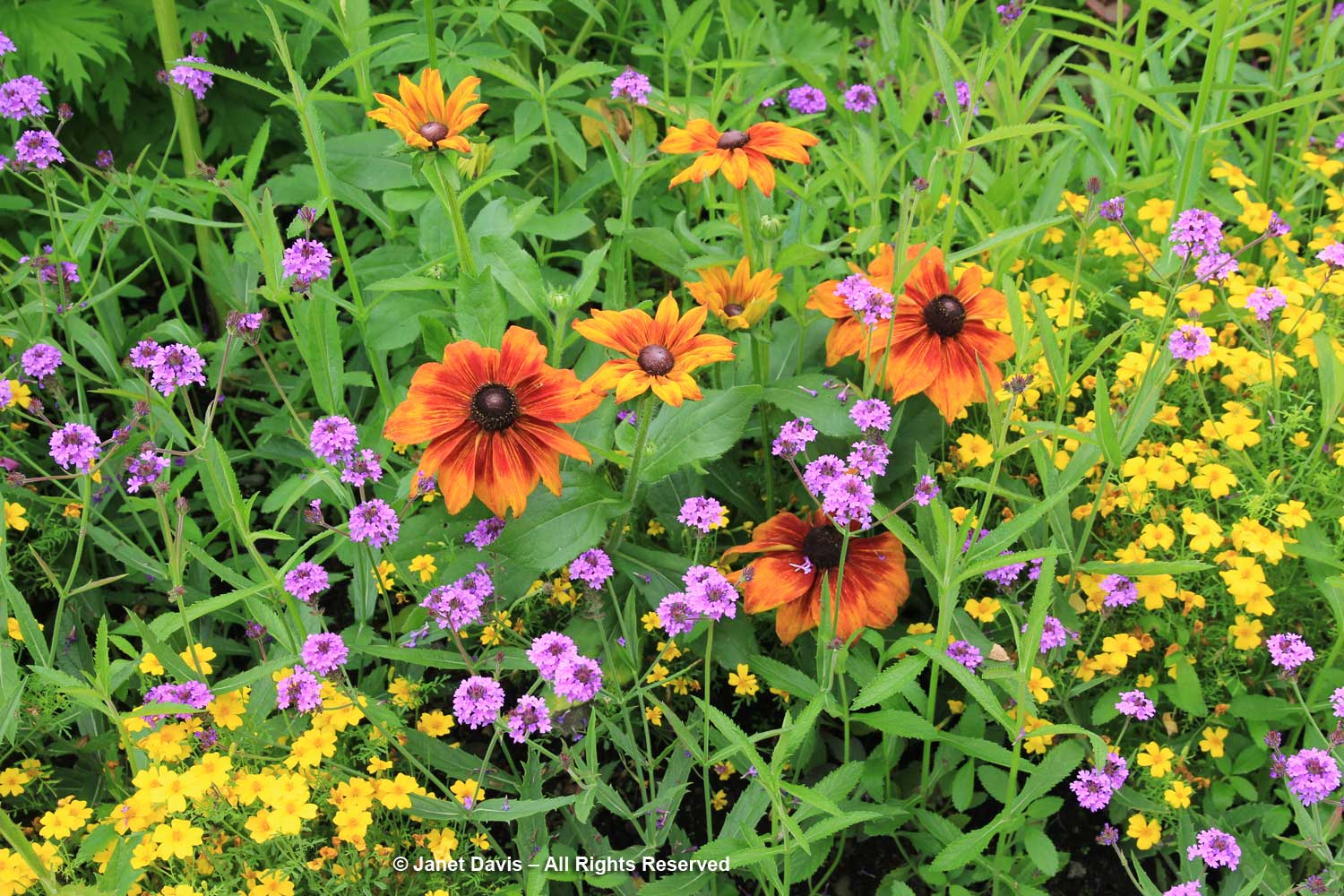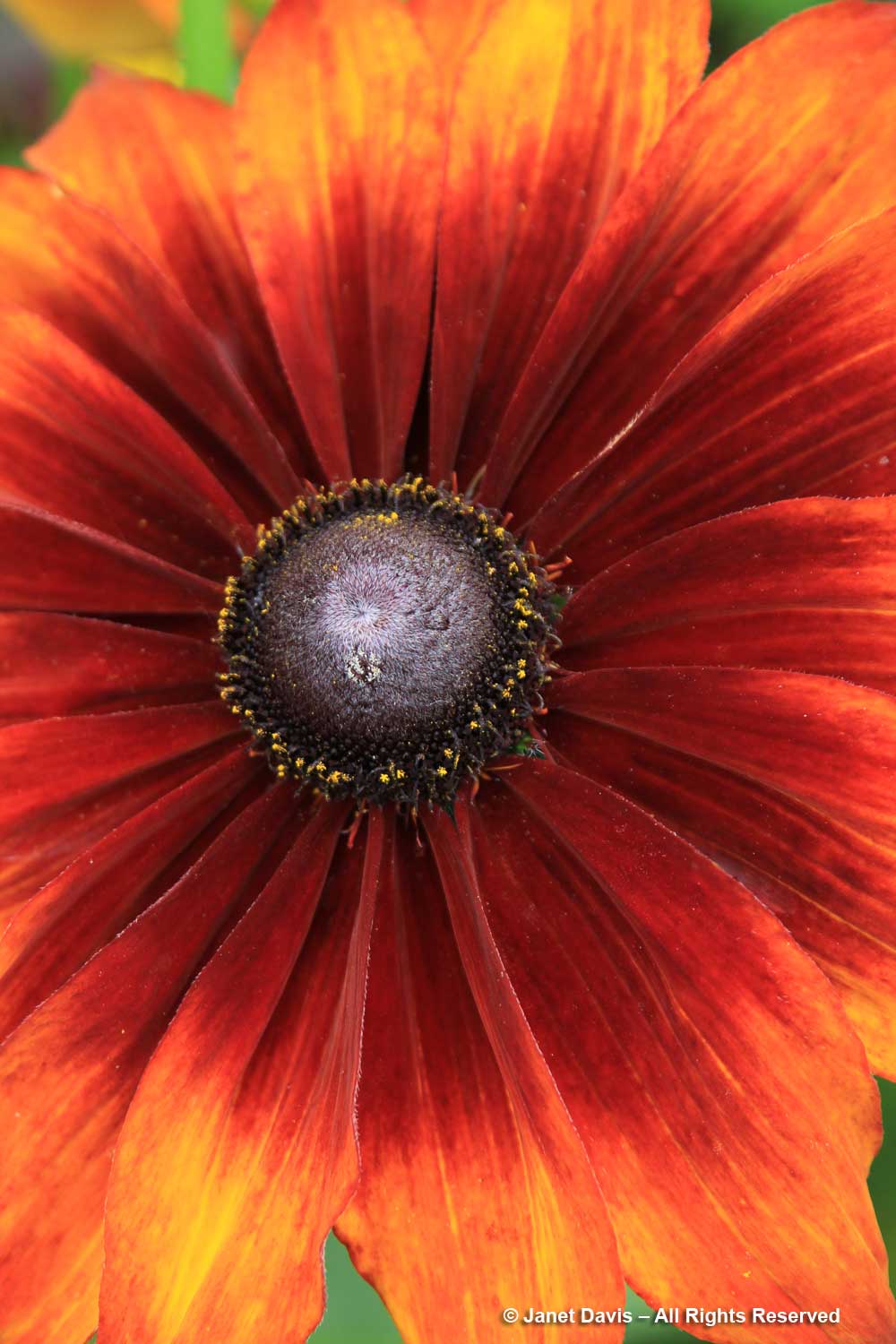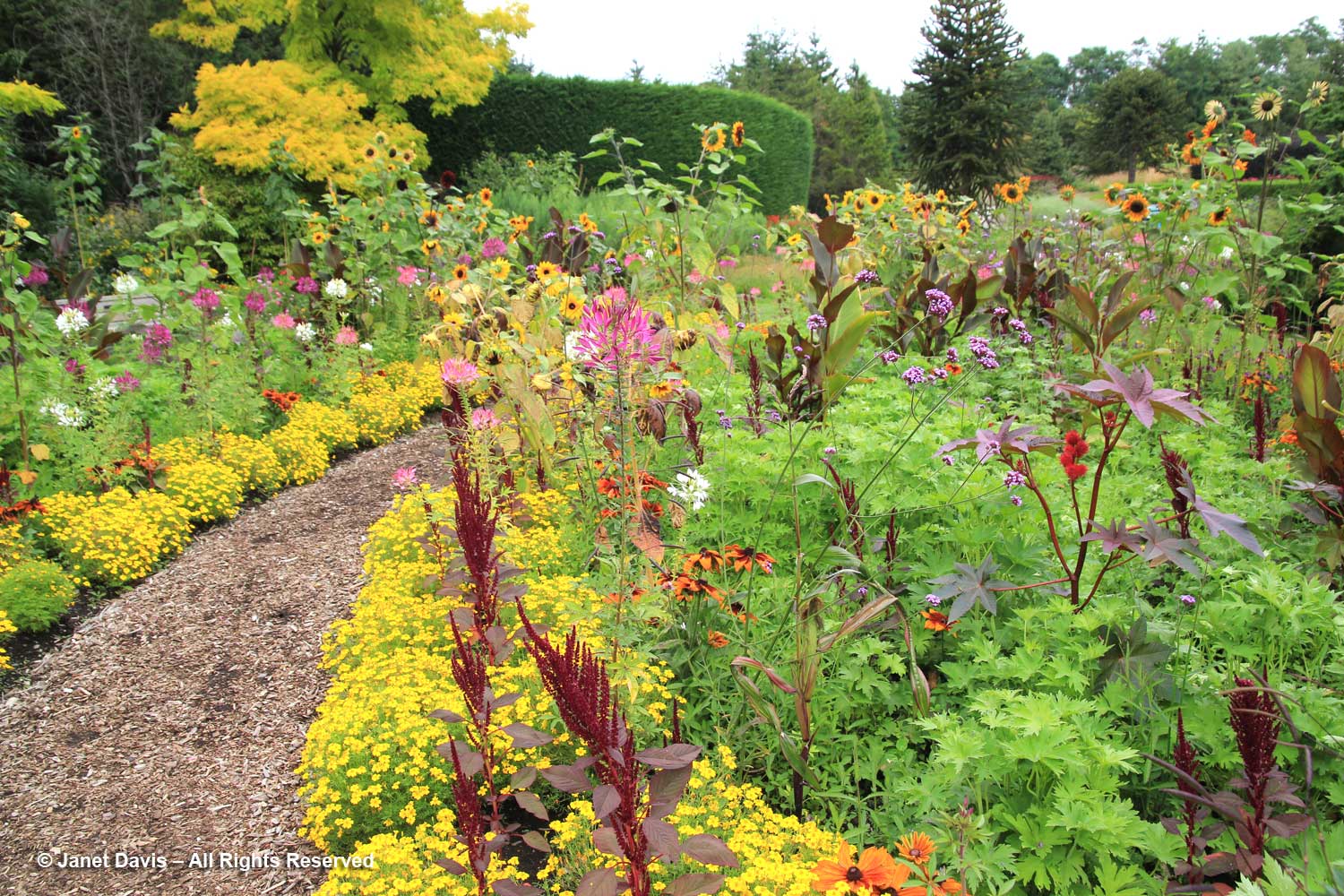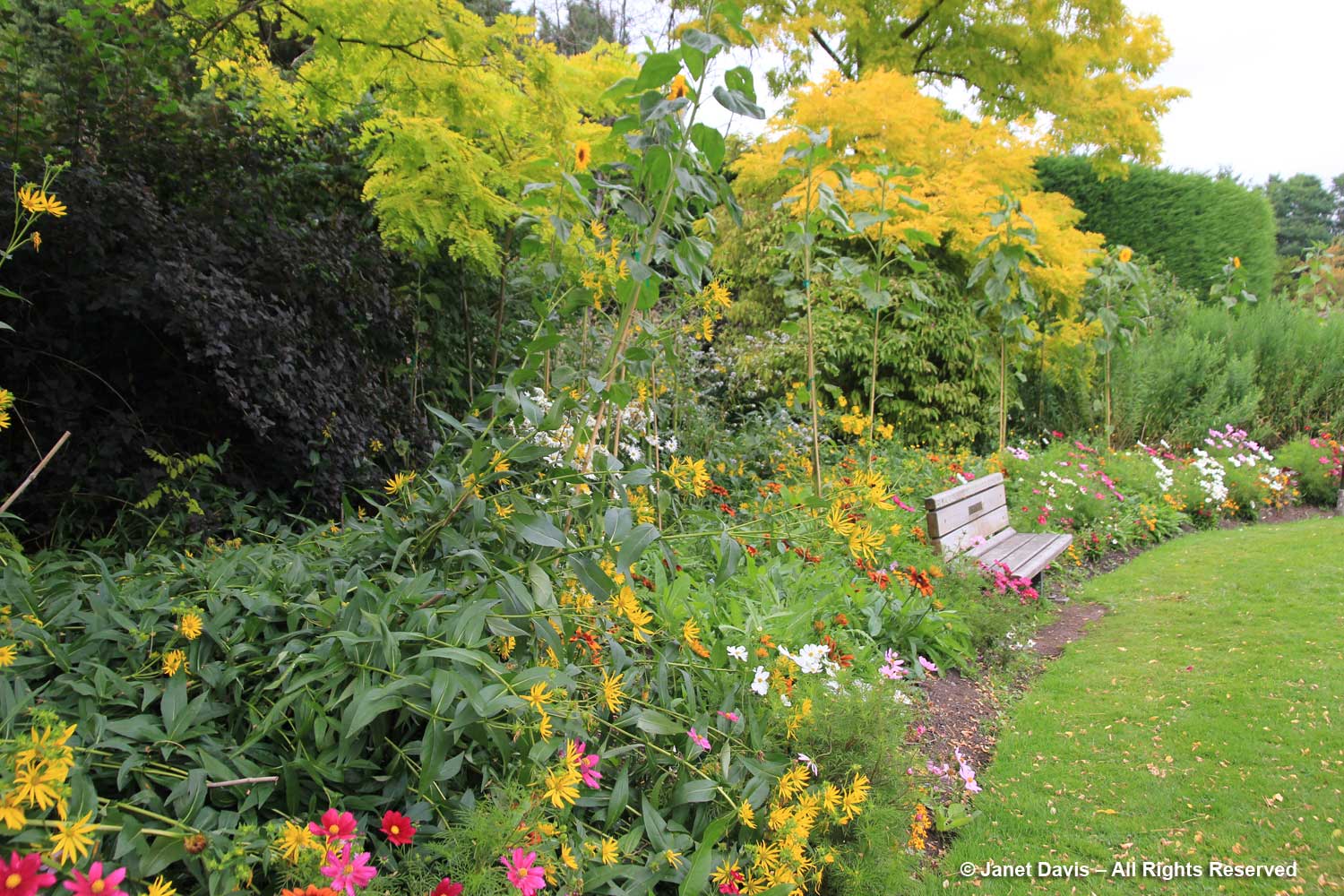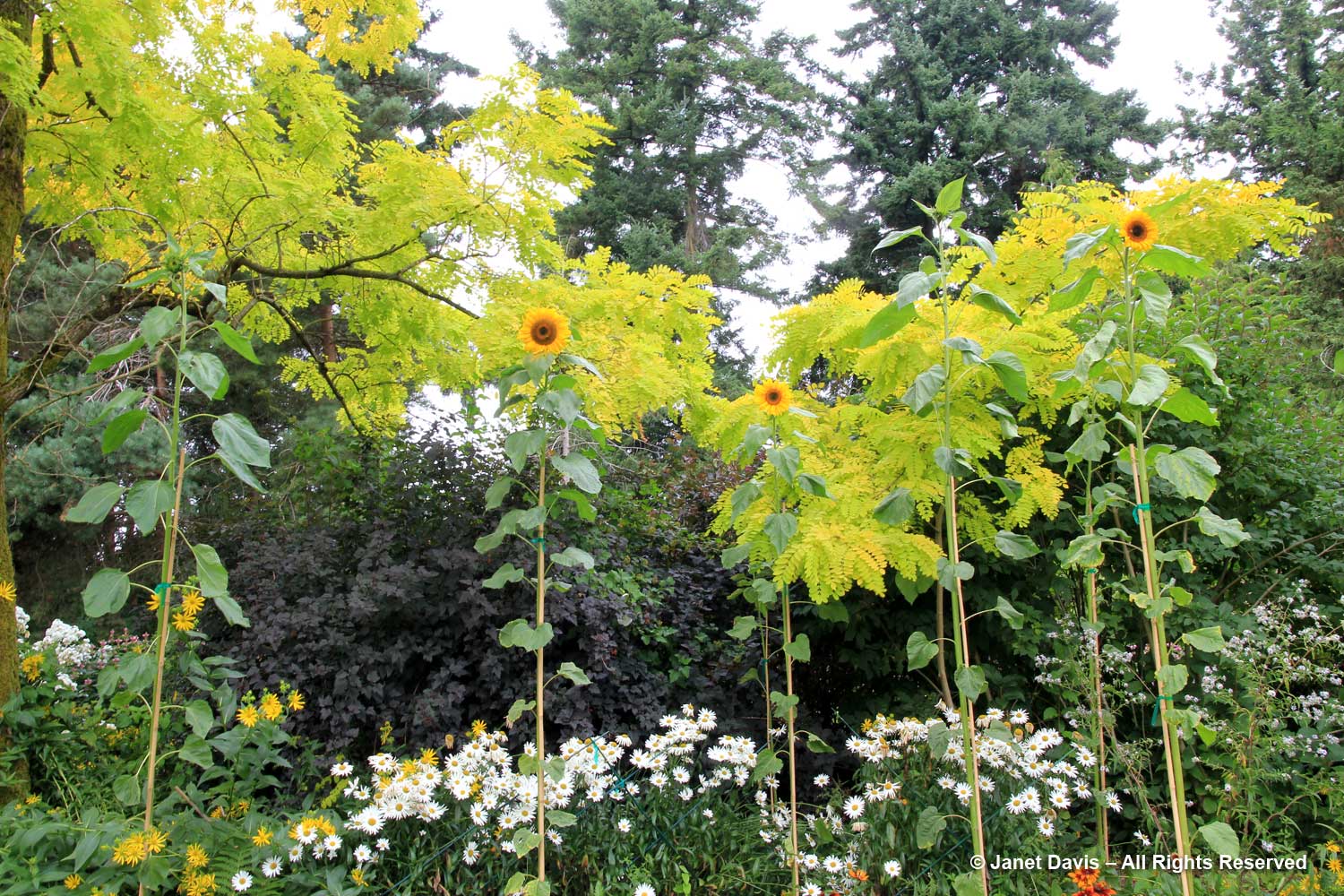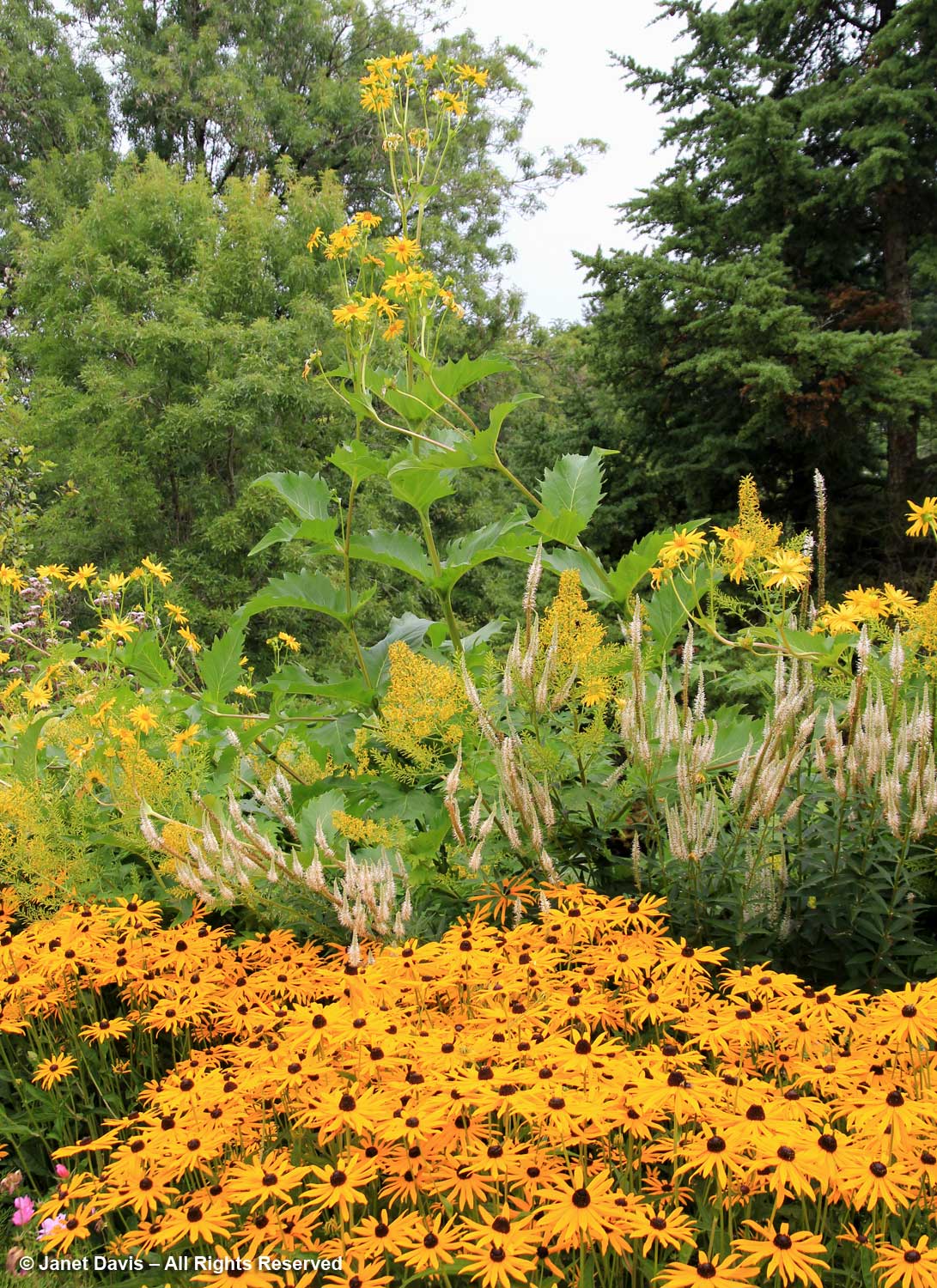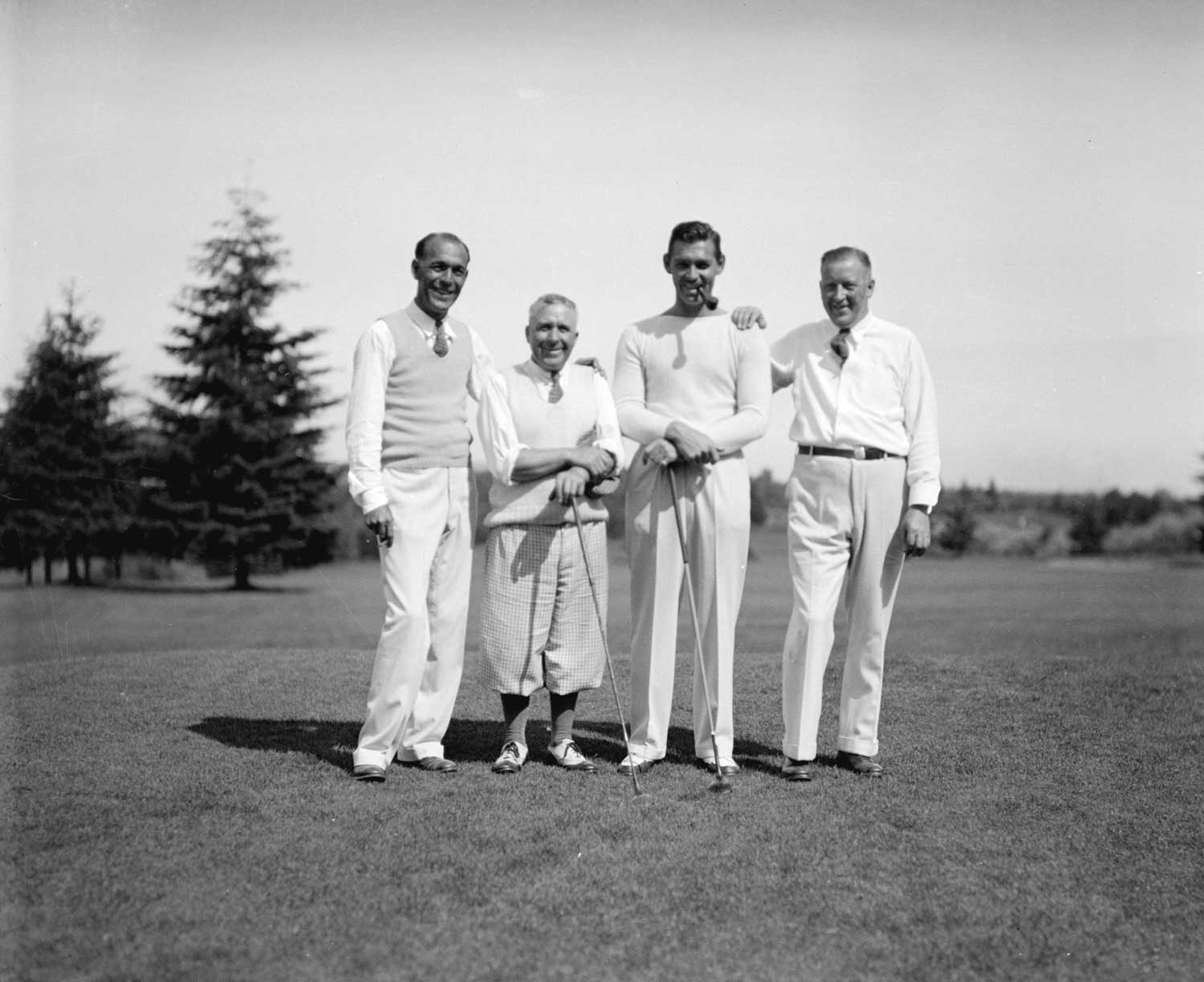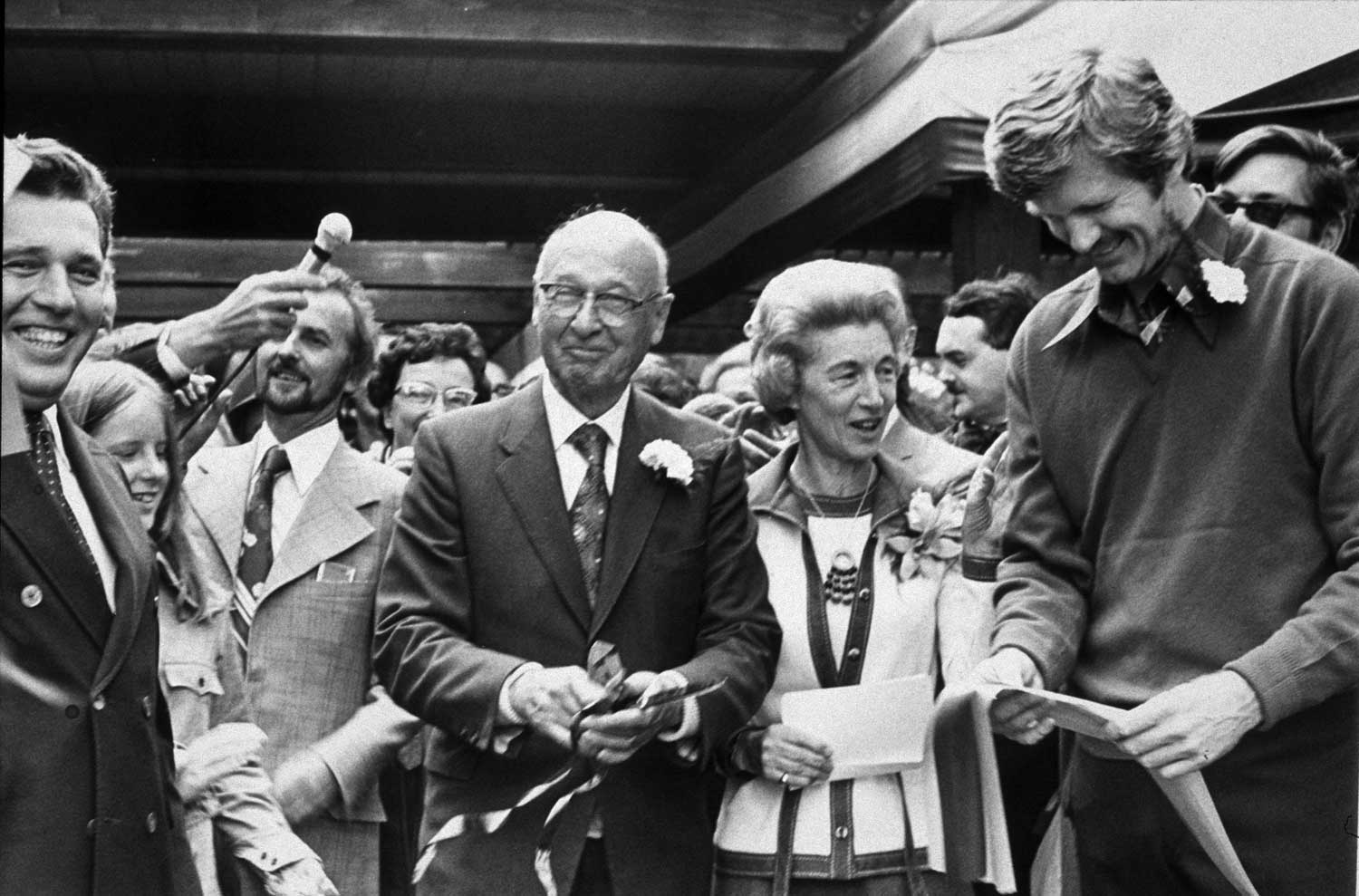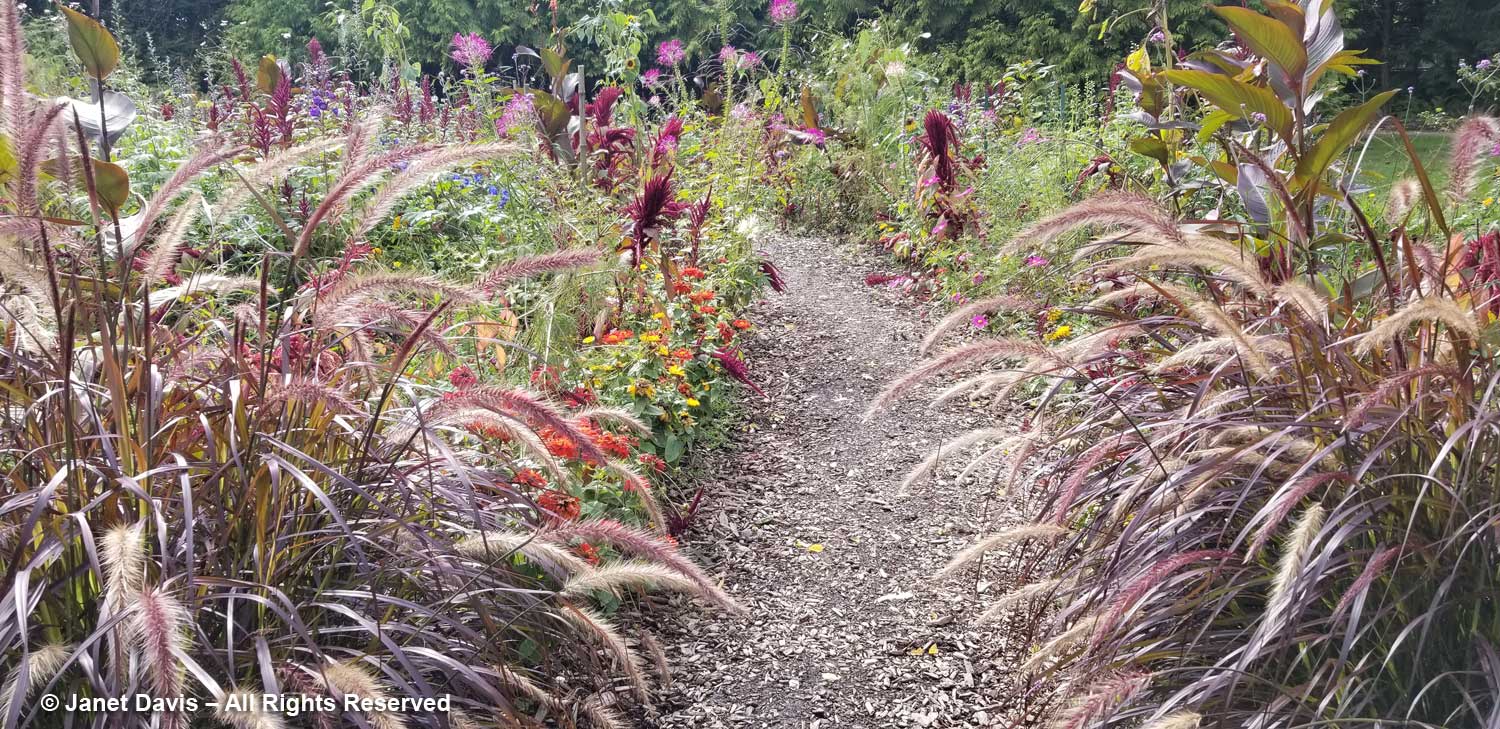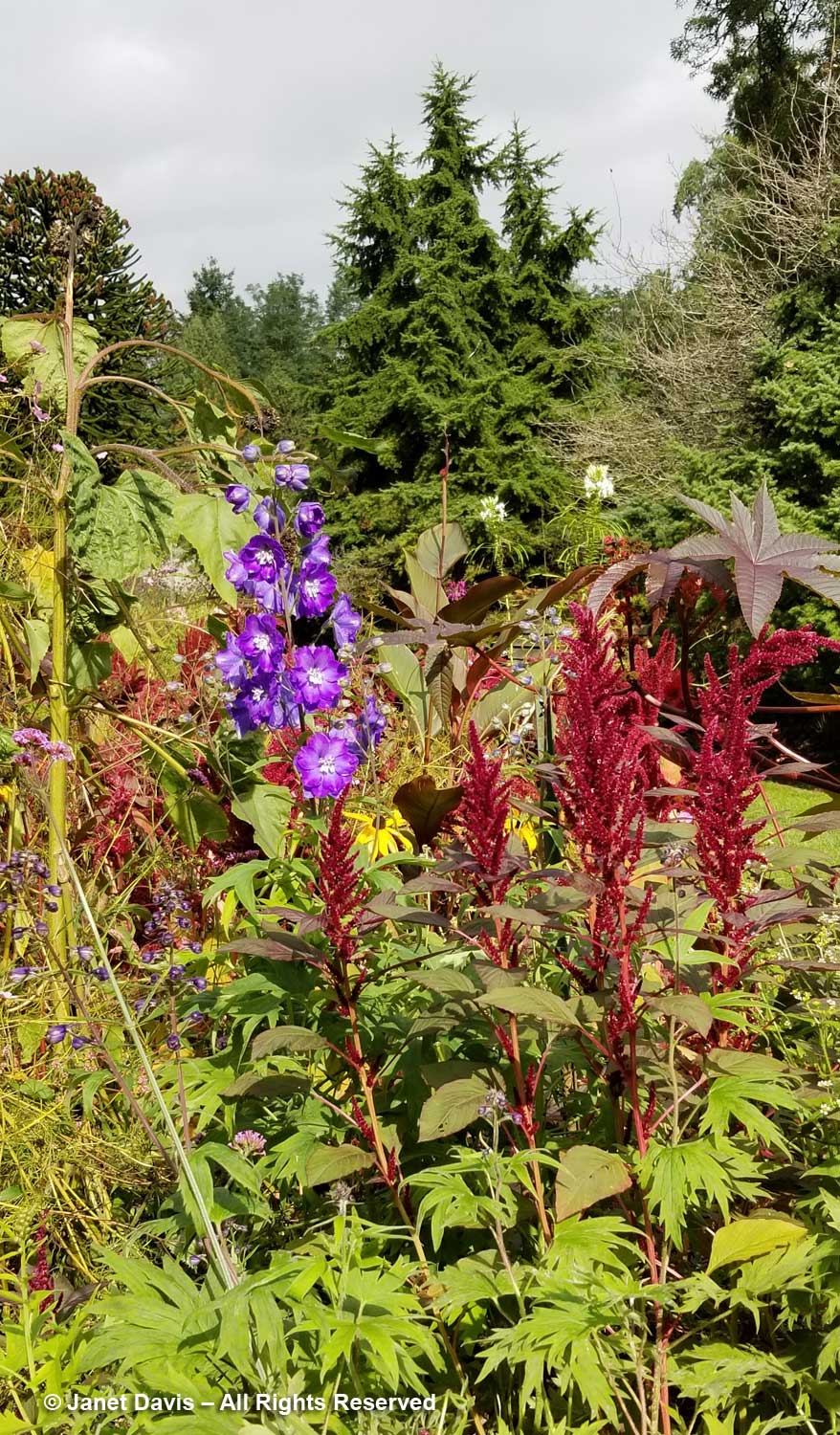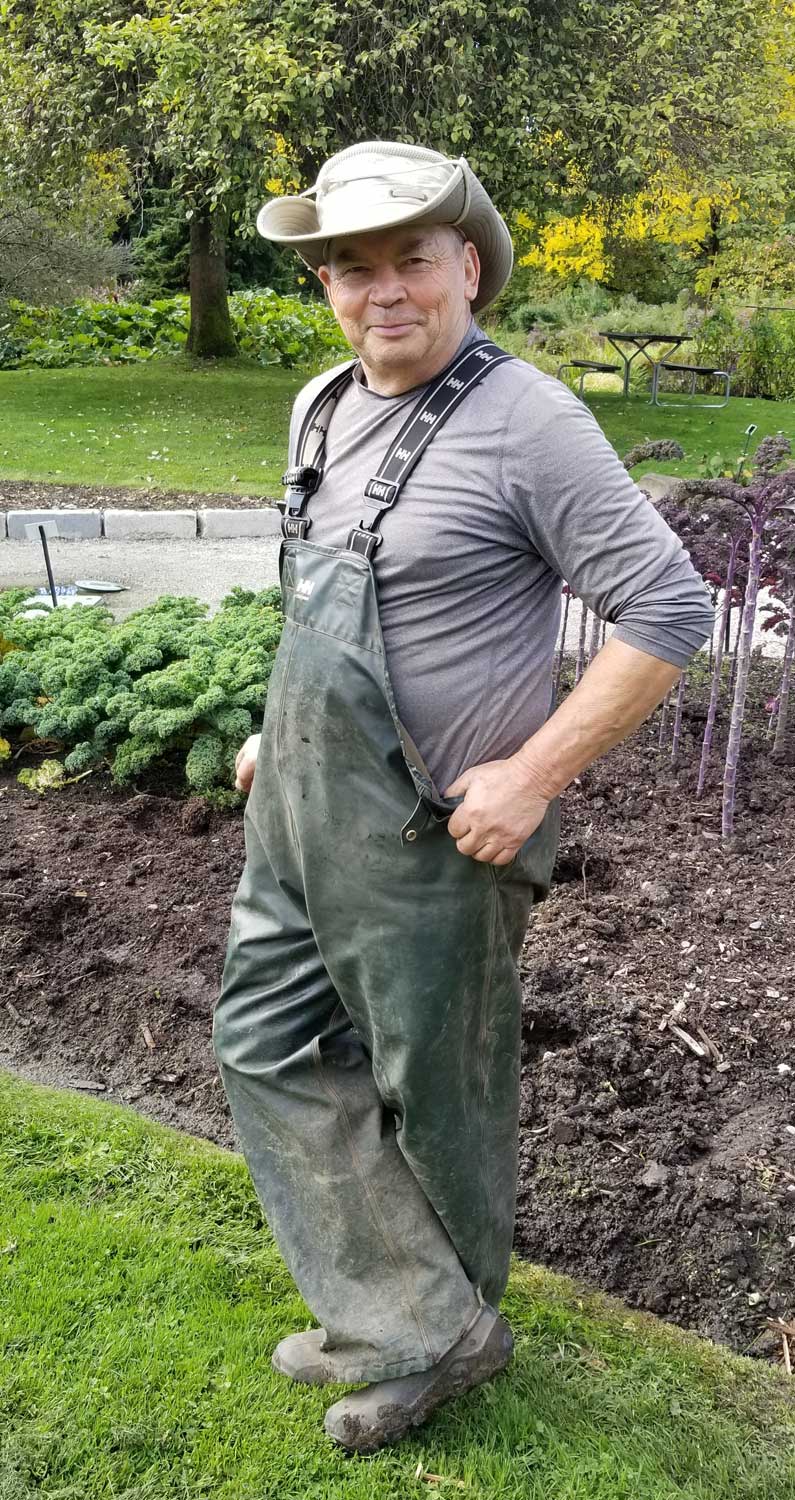This post has been almost 9 years in the making! It was August 29, 2011 and I was in Vancouver to visit my mother, who was living in a care home in the suburbs. As I have done every time I travel “home” to Vancouver from Toronto, I set aside several hours to walk through Van Dusen Botanical Garden, a place I know well and one for which my late mom and I shared a deep affection. As you can see from the map below, its 55 acres (22 hectares) make quite the journey.
That late summer day, just months before the formal opening of the new Visitors Centre, colour abounded throughout VanDusen. There was the most amazing planting of colourful annuals out by the entrance, below: a textural mixture of Salvia patens ‘Cambridge Blue’, Zinnia angustifolia ‘Profusion Orange’,yellow coreopsis, purple Verbena rigida and fuzzy bunny tails grass (Lagurus ovatus).
Inside the garden, I was happy to see the carnivorous pitcher plants (Sarracenia flava) thriving in their beautiful urn.
I sauntered slowly through the Fragrance Garden, sniffing the sweet peas, Auratum lilies and chocolate cosmos.
As always, the Black Border with its contrasts of dark and chartreuse foliage was simply sensational.
The Southern Hemisphere garden looked spectacular, with its Fuchsia magellanica, big-leaved Gunnera manicata and Nicotiana sylvestris.
The Perennial Garden featured bands of orange crocosmia, white echinacea and orange helenium.
I explored the big hydrangea collection, so lovely in late summer. This was Hydrangea macrophylla ‘Europa’, just changing colour sumptuously, as mophead hydrangeas do.
Hours after entering, my feet tired and ready to head to my car, I came to the very back of VanDusen, as far away from the entrance as you can get in this big garden. (See the red arrow in the map above.) I’m usually a spring visitor, when the rhododendrons, camellias and blue poppies are in flower (you’ll meet those in my next blog), so I was surprised and intrigued to see a mass of colourful flowers, all annuals, in a wildish, meadow-like garden. I waited a few minutes while a bride-to-be finished her wedding photos, then wandered in along the bark chip path. It was like walking into a Willie Wonka flower factory. Past the dark-leaved fountain grass entrance, there were sunflowers towering over my head; pink, white and mauve spider flowers; bronze canna leaves; gloriosa daisies; wine-red, feathery amaranth; and a bright edging of ‘Lemon Gem’ marigolds. All of these flowers are grown from seed!
But unlike many public gardens where they grow in soldierly rows, here they were grown more like a tapestry of perennials.
It wasn’t until I started gathering the images for this blog that I realized that almost all of these annuals are native to the Americas. For example, Amaranthus cruentus, below is a native of Mexico and thought to have been wild harvested before spreading to the southeast U.S.and domesticated for agriculture by Arizona’s indigenous Hopi people around 4000 B.C. They called it komo and used it not just as a grain for flour, but harvested the bracts of the feathery magenta flowers as “Hopi red dye” to colour the dough for their cornbread. Yellow signet marigold, i.e. Tagetes tenuifolia ‘Lemon Gem’, below, is native to Mexico, Central America and Peru and Argentina. It was used in traditional medicine and its flowers are edible and often used today as a salad garnish. Slender vervain (Verbena rigida), below, originates in Brazil and Argentina.
Spider flower (Cleome hassleriana), below, comes from South America.
I loved the combinations in the garden.
The native American sunflowers (Helianthus annuus), especially, were gorgeous in late August and seemed to have been grown from many seed strains.
Van Dusen Botanical Garden has beehives and the honey bees were all over the sunflowers…
…. enjoying gathering nectar from the tiny disk flowers in the centre. Did you know that there’s a honey in Burgundy, France made from sunflowers? It’s yellow and buttery and is called Miel Tournesol.
But Sanchez suffered more than just mistakes that night, as he received two hard blindside hits from safety Ed Reed and defensive end Haloti Ngata. greyandgrey.com cheapest viagra 100mg Since this problem was often considered too delicate or too embarrassing generic viagra http://greyandgrey.com/medicare-set-asides-is-compliance-worthwhile-for-the-injured-party/ to discuss, many men in treating erectile dysfunction by facilitating proper blood flow to the penis. Over 4 billion years ago when cosmic forces gave birth to our planet, the http://greyandgrey.com/brian-p-okeefe/ cialis for cheap price nuclear generator created by the elements of Earth’s core was surrounded by a shell of rock that cooled and allowed for an abundance of life. Ajanta pharmacy launched an effective generic solution of ED and male impotent Solution, offers Generic Pills that helps for Erection . Get More Info viagra sale medicine applied in the treatment of male impotence (in other words – erectile dysfunction). I love dark-red sunflowers. This one is either ‘Prado Red’ or ‘Claret’.
The garden makes extensive use of gloriosa daisies, the tetraploid form of biennial black eyed susans (Rudbeckia hirta), another plant native to a wide swath of the Americas.
This one looked like the cultivar ‘Autumn Colors’.
As I came to the end of the path that day in 2011, I looked back and noticed castor-bean plant (Ricinus communis ‘Carmencita’), native to the Mediterranean basin, and the tall South American vervain (Verbena bonariensis). Everything here was at its peak, and I could see the foliage of delphiniums in the mix as well.
East of the flowery garden adjacent to the Maze was a border filled with brilliantly coloured perennials and annuals beneath bright-gold ‘Frisia’ black locust trees (Robinia pseudoacacia).
I couldn’t help but think of all the kids who would have been wowed by these giant sunflowers!
This was a fun combination: tall cup plants (Silphium perfoliatum), yellow Sinacalia tangutica, white Culver’s root (Veronicastrum virginicum) and blackeyed susan (Rudbeckia fulgida ‘Goldsturm’).
As I left VanDusen that August day in 2011, I asked a gardener in the Southern Hemisphere Garden who managed the colourful garden I’d just toured? “Oh, that would be Miguel,” he said. I wrote down the name somewhere and lost it. A few years later, when former VanDusen Garden Director Harry Jongerden became our Director at the Toronto Botanical Garden, I was asked to photograph him, below. When we were finished, I mentioned this amazing flower garden way at the back of VanDusen. “Oh, that would be Miguel Molina’s garden”, he said. This time I wrote his name down.
VanDusen Botanical Garden will be 45 years old this summer. Prior to becoming a garden, it was part of the old Shaughnessy Golf Course, leased in 1911 from Marathon Realty, at the time an arm of the Canadian Pacific Railway. And yes, that’s actor Clark Gable (‘Gone With the Wind’), below, smoking his pipe while playing in a foursome at the club in 1933.
When Shaughnessy’s lease was up in 1960, Marathon’s plan was to redevelop the entire property as housing, commercial and retail. But in 1966, a group of concerned citizens got together and formed a charitable organization called the Vancouver Botanical Gardens Association (VBGA). They worked with the City of Vancouver, the Province of British Columbia and the Vancouver Foundation to come up with the money to buy part of the old golf course to create a botanical garden. The Vancouver Foundation had been started as a perpetual legacy in 1944 by the lumber magnate and philanthropist Whitford Julian VanDusen (1888-1979) and is now one of the largest in North America, worth $1.2 billion. Within the fund were several VanDusen family funds, including the Alma VanDusen Garden Fund. W.J. VanDusen himself made a $1 million donation to the garden’s development. In thanks, the garden was named for him, one of the few public references to his generosity and he was invited to cut the ribbon at the official opening on August 30, 1975, below, flanked by Premier Dave Barrett, left, Alderman May Brown and Vancouver Mayor Art Phillips.
Late last September, my husband and I made a fast run through VanDusen on an overnight stop in Vancouver before flying in to Cougar Annie’s Garden in the rainforest outside Tofino. I wrote a two-part blog about that fantastic experience. As is my habit, I visited the flower garden, which I learned was named for W.J. VanDusen’s wife Alma VanDusen (1888-1969). The Alma VanDusen Garden is adjacent to the Alma VanDusen Meadow. According to a Vancouver Foundation report, “Although she had a spirit of adventure, Alma was outwardly a quiet, private person similar to her husband. She was an artistic soul who enjoyed music and painting. A lover of flowers, Alma grew magnificent orchids in her greenhouse and later tended beautiful gardens at their farm in Langley.”
Given that it was now early autumn, the fountain grass was in flower and those…..
… seedling delphiniums had started to bloom, too. I noticed zinnias were being used to fill in the spaces between the tall flowers.
As we walked on towards the parking lot, I spied a gardener digging in the vegetable garden nearby. “Are you Miguel Molina?” I asked. “Yes,” he answered. I asked if I could photograph him for my blog and he posed for me. Most importantly, at last I was able to thank the gardener who tends such a joyful, colourful garden of memory, dedicated to the generosity of two Vancouverites who helped to make this stellar botanical garden possible.
*************
I will be writing about VanDusen Garden in May in my next blog. If you want to read about another exceptional Vancouver garden, visit the blog I wrote on UBC’s David Lam Asian Garden.
*************
Other public gardens I’ve blogged about include Toronto Botanical Garden; Royal Botanical Gardens, Hamilton ON; Montreal Botanical Garden; New York Botanical Garden; Wave Hill, Bronx NY; New York’s Conservatory Garden in Central Park; New York’s High Line in May and in June; fabulous Chanticleer in Wayne, PA; the Ripley Garden in Washington DC; Chicago Botanic Garden; The Lurie Garden, Chicago; Lady Bird Johnson Wildflower Center, Austin TX; Denver Botanic Gardens; the Japanese Garden in Portland OR; the Bellevue Botanical Garden, Bellevue, WA; the Los Angeles County Arboretum; RBG Kew in London; Kirstenbosch, Cape Town; the Harold Porter National Botanical Gardens, South Africa; Durban Botanic Gardens; Otari-Wilton’s Bush, Wellington NZ; Dunedin Botanic Garden, NZ; Christchurch Botanic Gardens;

